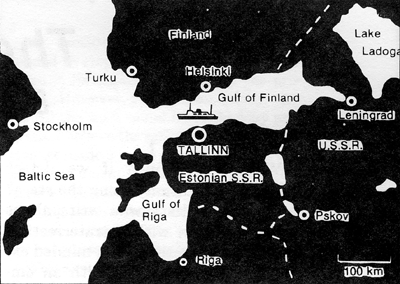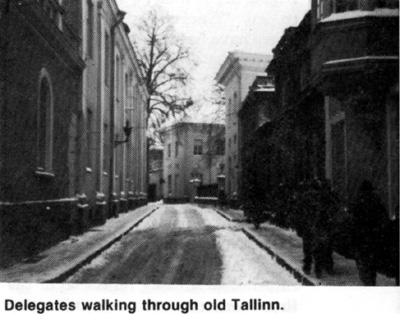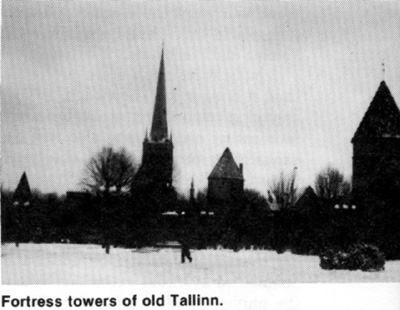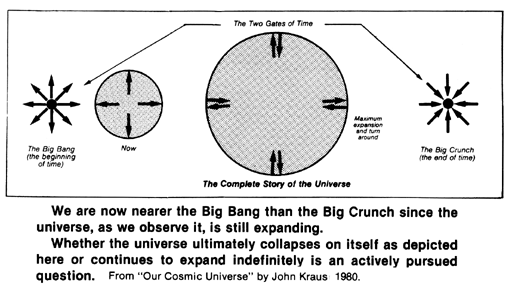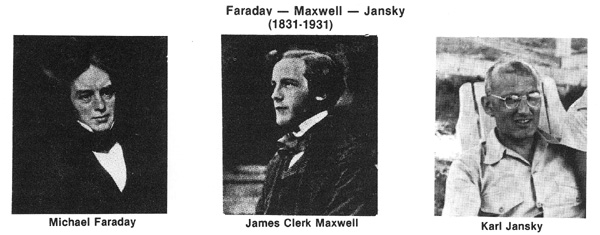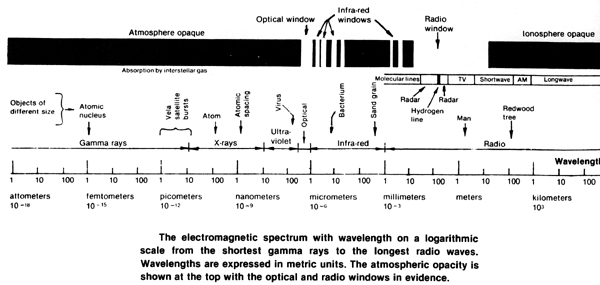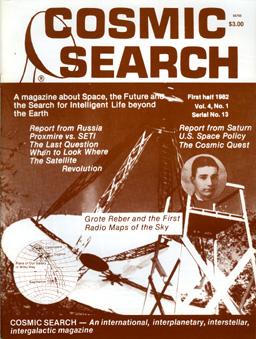![[NAAPO Logo]](../../Images/NAAPOsm.jpg)
North American AstroPhysical Observatory (NAAPO)
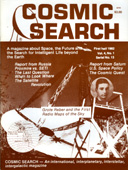
Cosmic Search: Issue 13
(Volume 4 Number 1; First half 1982)
[All Articles & Miscellaneous Items]
|
Webpage Table of Contents (Bookmarks)
(Internal links to items in this webpage)
[Note. Use Back button (or <Alt>+<Left Arrow>) to get back to this Table of Contents after you have clicked on a link and viewed the article.]
Codes Used Below:
P: Starting page of article in magazine; A: Author(s); T: Title of article
|
SETI Tallinn-81
Communication With Terrestrial Intelligence
By: Frank Drake
Just ten years ago a remarkable international conference on SETI was held by the U.S. and U.S.S.R. National Academies of Science. That conference, at Byurakan, in Soviet Armenia, was a milestone in the history of SETI; it brought together for the first time the leading figures in SETI from the two countries which have most actively pursued the subject. The discussions then gave guidance in both countries as to better approaches to SETI. Now ten years have flown by, and time for a new planet-wide SETI symposium. In response, from December 8-11 1981, the Soviet Academy of Sciences, along with several other Soviet groups, sponsored an "All-Union" SETI Symposium, and invited active SETI researchers from all over the world. Some thirty people from the United States were invited, but the shortage of travel funds and other obstacles prevented most from attending. Indeed, were it not for a timely travel grant from the Sloan Foundation, there would have been very few Americans present. In the end, a total of 10 Americans, of which I was one, attended this conference in another world and about other worlds.
The symposium was held in an unlikely place, Tallinn, in the Estonian Soviet Socialist Republic, not far from the Arctic Circle. It is one of the most northerly places on earth inhabited by a substantial number of humans and is an old city on the shores of the Baltic Sea.
It is cold; it snows every day, and it is dark, somewhat to the surprise of even the astronomers present. In December the first glimmers of dawn only show through the clouds about 9 in the morning, and the sun barely rises by about 10:30. It then hovers tentatively just over the southern horizon until it sets about 2:30. (Tallinn is on Daylight Saving Time!) By 4:00 the city is in total darkness, and the citizenry can be seen scurrying through the snowy streets bundled up in fur coats and caps. Nevertheless, life for us was not so grim. One of the reasons the symposium was held there is that it boasts two of the most modern and comfortable hotels in the Soviet Union, and as a result, living arrangements were much better than at Byurakan, although not elegant by American standards. There was also a practical benefit to the American participants; one can get to Tallinn by a direct flight to Helsinki, Finland, from either the West coast or the East coast, at "super-saver" fares. From Helsinki a luxurious ferry boat takes you to and from Tallinn in about 4 hours. This route of travel so reduced travel costs to the U.S.S.R. that there were about twice as many participants from the U.S. than otherwise could have been supported by the Sloan Foundation funds.
Once in Tallinn, we spent a non-stop three and one-half days attending the Symposium and hearing a deluge of papers on all aspects of SETI. Indeed, the total number of participants was more than double the number at Byurakan, clear evidence of the growth of SETI in the scientific field. However, the number of Americans present was less than half that at Byurakan, while the number from the U.S.S.R. had more than doubled, to over a hundred, as best I could tell.
Two things were striking to the Americans present. One was the great respect paid to SETI and to science in general in the Soviet Union. When we arrived in port at Tallinn we were given priority treatment in passing through customs, which is a remarkable event in that country where customs agents are as hard-headed and unbending as anywhere in the world. That did not stop the agent who checked me from looking through every one of the six copies of "COSMOS" I had brought on behalf of Carl Sagan, or looking at every one of my slides, but it certainly was a chink in the System. Then, we found that everywhere we went we got priority treatment. The most heady spectacle was the police escort that was provided our bus every time we went anywhere, daytime or nighttime. This escort usually consisted of two "militia" cars, each with four uniformed men, who went slaloming ahead of us, lights flashing, to stop traffic at each intersection we came to, so that we could go relentlessly through stop signs and red lights.
Another indication of the prestige of SETI was the presence at the meeting of four cosmonauts and one member of the Supreme Soviet, the equivalent of a Member of Congress. One cosmonaut, Vitaly Sevastianov, attended almost every session. He is one of the most reknowned of the cosmonauts, having flown in space three times, and in addition presents a popular science program shown on TV monthly throughout the Soviet Union. He is also President of one of the major chess clubs, is a gymnast, and turned out to be a friendly, extremely bright, and personable man. There were a large number of people from the press and TV present, and this in the end became a problem because of the almost rude competition which took place to obtain interviews with the visiting scientists. Several
times the Americans wondered to each other if such a variety of displays of interest and support would ever occur in America.
The other striking phenomenon, which kept rearing up throughout the course of the symposium for SETI, was the difference in intellectual discipline between the American and Soviet studies of SETI. Somehow the level of peer review, interpersonal discussion and criticism, the weeding out of the unsound or spurious, has been very much greater in the U.S. than in the U.S.S.R. Over the years the subject of SETI has been debated and criticized over and over in the U.S., especially in recent years through the workshops and symposiums organized by the SETI group at the Ames Research Center. Our thoughts on SETI have been thoroughly examined, and we are clear on what hypotheses can stand a swipe from Occam's Razor, what the potentials of real radio telescope search systems are, or what is speculative but still possible to embrace intellectually.
The many Soviet presentations led to the clear conclusion that there was far too little mutual contact, mutual criticism, and peer review in Soviet science. The papers ranged from excellent, to, well, preposterous; somehow no one had lowered the boom on those who violated the basic tenets of true science. It was clear that many of the senior Soviet scientists present were quite aware of this weakness and were somewhat embarrassed by it.
Thus, we heard a presentation which proposed that the ideal message to send to another civilization was 102 + 112 + 122 = 132 + 142 because this was somehow mind-catching. It was pointed out that the above sum also equals 365, the number of days in a year (forgetting that the year is actually about 365.26 days), which is somehow significant; it was even suggested that the ETIs had adjusted the rotation of the earth to bring this striking equality about! We heard suggestions, based on some Viking pictures, that there are mammoth ETI-made monuments on Mars. There was talk about "paleo-contacts," in the venue of Von Daniken. It was proposed that super-civilizations would build solar-powered stations half way between their space colonies and their star in order to increase the thermodynamic efficiency of the solar cells employed. It was suggested that some unusual celestial objects, such as the object SS433, were the products of ETI. It was proposed that the "blue straggler" stars, were dying stars being kept alive by ETI, who are throwing hydrogen "logs" into them to keep the nuclear fires burning.
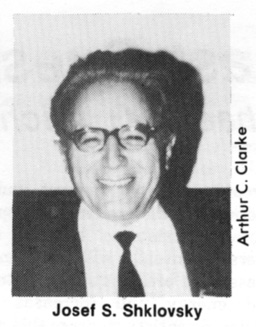
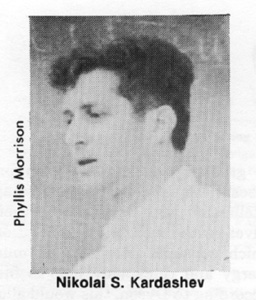 Amongst a great deal of this there were some important papers. I.S. Shklovsky, one of the SETI pioneers, voiced his worries that ETI may be very rare in the universe, and that evolution on the earth is at a dead end. Nikolai S. Kardashev gave arguments as to why the central portions of galaxies would be good regions for SETI searches. M. Ya. Marov, a leading planetary scientist, gave a careful analysis of the energy requirements of multistage relativistic rockets utilizing nuclear fusion reactors and suggesting that in the long run some limited programs using such rockets might make sense. Several papers examined the potentials of additional approaches to SETI other than the classical radio search. These included discussions of the problems of direct photography of planetary systems, infra-red emissions, astronometry, etc. The conclusions were similar to those in the U.S., namely that radio searches were the most promising for the detection of civilizations, while the optical search for perturbations of stellar proper motion were the most promising approach to the detection of other planetary systems. There also was considerable sentiment for a careful study of any peculiar infra-red source to determine if it just might be an artifact of some large-scale engineering enterprise.
Amongst a great deal of this there were some important papers. I.S. Shklovsky, one of the SETI pioneers, voiced his worries that ETI may be very rare in the universe, and that evolution on the earth is at a dead end. Nikolai S. Kardashev gave arguments as to why the central portions of galaxies would be good regions for SETI searches. M. Ya. Marov, a leading planetary scientist, gave a careful analysis of the energy requirements of multistage relativistic rockets utilizing nuclear fusion reactors and suggesting that in the long run some limited programs using such rockets might make sense. Several papers examined the potentials of additional approaches to SETI other than the classical radio search. These included discussions of the problems of direct photography of planetary systems, infra-red emissions, astronometry, etc. The conclusions were similar to those in the U.S., namely that radio searches were the most promising for the detection of civilizations, while the optical search for perturbations of stellar proper motion were the most promising approach to the detection of other planetary systems. There also was considerable sentiment for a careful study of any peculiar infra-red source to determine if it just might be an artifact of some large-scale engineering enterprise.
There is an impressive and exciting program of major instrument construction in the Soviet Union. V.S. Troitsky, long a leading figure in the Soviet SETI program, described a new system to be built especially for SETI. It will utilize about 100 antennas of 1-meter diameter, operating at the famous 21-centmeter wavelength and so designed as to allow continuous observation of all the celestial sphere which is above the horizon. The first portion of this system will go into service in 1982, and will provide a sensitivity about 1000 times better than has been available to Troitsky and his colleagues at Gorky. It will use up-to-date radio receivers.
A major approved project was described by Kardashev involving the construction of an extremely precise 70-meter fully-steerable parabolic telescope. Primarily for astrophysical study, the telescope will be placed on an excellent site at an elevation of about 2500 meters near Samarkand. Its surface will have an accuracy better than one millimeter. This is a $75 million project and will provide an instrumental capability far exceeding that available anywhere else. Measurements on a similar existing antenna have shown useful efficiency at even the shortest milimeter wavelengths. It is expected that the telescope will be finished within five years, and Kardashev hopes to devote a substantial portion of its time to SETI.
There is also a well-planned and impressive program to install and operate radio telescopes in space. This will commence with the second launching of a 10-meter telescope in a low orbit to be used primarily as an interferometer antenna paired with antennas on earth. Similar projects have been discussed in many countries, and offer great promise for the achievement of high-quality, high-resolution radio images of such objects as quasars and galactic nucleii [sic; "nucleii" should be "nuclei"]. In the long run such telescope systems may be the most powerful of all radio telescopes. There are already projects in the Soviet Union for more advanced systems of the same kind. These include the launching of similar antennas into higher orbits, so as to obtain better resolution, and the launching of a high-precision antenna which will operate well at wavelengths of 1 millimeter and less. Most grandiose is the plan to launch a large antenna instrumented on many frequencies into a highly elliptical orbit ranging from 2000 to about one million kilometers from earth. Not yet finalized are plans for a similar system which separations from the earth of several times the distance of the earth from the sun.
The American group at the symposium presented a package of succinct, highly informative papers which received a great deal of attention. Bernard Oliver, gave a very clever discussion of methods of transmitting interstellar signals in the form of pulses which would maximize signal-to-noise ratio, and suggested that we be alert to such transmission modes. A. Schwartzmann reviewed the hypotheses of the sociology of advanced civilizations, including such matters as space colonies and interstellar colonization. He is partial to the idea that civilizations have an ethic which inhibits them from intervening in the affairs of other civilizations, and this may explain the lack of direct contact with the earth.
Jon Lomberg gave a fascinating talk about the design and contents of the interstellar message carried on a phonograph record by the Voyager spacecraft. This immediately made him very popular to all the Soviet participants, and particularly to the press! Woodruff Sullivan, gave an ingenious analysis of the effect of variations in the brightness of civilizations on search strategy, showing the advantages of searching close to the plane of the Milky Way galaxy.
Paul Horowitz described his design of a "suitcase" SETI system, a portable and inexpensive digital computer which is designed to perform SETI searches at a variety of telescopes. His system is almost ready for use. I described some mathematical formulations which can be used to judge the relative chances of success of different SETI programs. I also described hypotheses which suggest that searches might be best done at millimeter wavelengths (a conclusion independently reached by Kardashev), and suggested some approaches for building large millimeter wavelenth telescopes for SETI derived from our experiences at the Arecibo telescope.
George Gatewood, described his very impressive success in measuring stellar perturbation far more accurately than heretofore, and his success in making a very old refracting telescope in Pittsburg, [sic; "Pittsburg" should be "Pittsburgh"; the telescope is located at the Allegheny Observatory of the University of Pittsburgh in Pennsylvania], of all places, perform so well that it should detect other planetary systems in only a few years. This work seems to represent a real breakthrough in the problem of detecting other planetary systems.
Robert Dixon gave an excellent and detailed description of the results of the long-term SETI program which has been carried out with the large radio telescope of the Ohio State University. Many useful lessons have come from his experiences, as well as the very tantalizing signals from somewhere in the sky, however, it is not possible yet to say if they came from the sky of earth or the skies of some other worlds. The need for more analysis equipment is evident, and every one wished that the means to procure it would be found.
Jill Tarter, presented a quantitative description of the "Cosmic Haystack" the combination of dimensions which must be searched for SETI signals. These include directions in the sky, frequencies, signal levels, band-width and transmission time. She showed how far past searches have delved into the "haystack" and demonstrated that we have a long way to go to find the needle. Samual Gulkis [sic; "Samual Gulkis" should be "Samuel Gulkis"] described the planned NASA SETI program, the program which recently lost its funding due to actions of the U.S. Congress.
Finally, as the concluding contribution to the program, Jill Tarter gave a careful and thorough review of all the SETI programs carried out anywhere in the world up to the present. From this it was very clear that there has been a great deal of activity in SETI. At the same time we have a long way to go before we can say realistically that we have searched the cosmos with a diligence which is deserving of sucess.
As a final order of business, the Soviet participants prepared a resolution to their own government concerning SETI. This was a balanced, well-reasoned document which presented a realistic and strong case for major support for SETI projects in the U.S.S.R. It also evoked the only political discussion of the entire symposium. Buried in the resolution, very innocently it seemed to me, was a statement condemning extremist or fanatical position, either pro-SETI or anti-SETI. Shklovsky was very irritated by this, taking it as an attack on his point of view and, surprisingly, to the Americans at least, as a threat to his freedom of thought. He gave an impassioned speech reminding the participants of the Lysenko affair, where science was run by government fiat rather than true scientific principles, and suggested that the offensive statement smacked of a return to such a bad approach. There seemed to be much sympathy for him, but the statement in question stayed in the resolution which was passed unanimously.
After the sun had set on this last day of the conference, the Americans met with Kardashev, Troitsky, and a few others to discuss possible joint programs in SETI. Everyone agreed that this was a good idea, since it would allow the sharing of resources — Soviet telescopes and American computer know-how. It would reduce costs, and bring more minds to bear on the problem. Sad to say, we from America could only speak tentatively, for there is now no SETI program in America and all major funding for SETI is stopped, at least for the present. Whereas the leading Soviet astronomers were in a position to offer concrete plans and tentative commitment, we could only indulge in wishful thinking. We had to leave these possibilities up in the air, to be taken up seriously at such time as SETI becomes an American endeavor again. For us there was an air of disappointment to this: to have come so far, to have shared facts, exciting possible projects and dreams, and
then, much like the extraterrestrial creatures in "Close Encounters of the Third Kind," to do no more than turn away and walk silently into the darkness.
The time had flown, and now there was only time for hurried good-byes and a quick bus ride through the snowy night to the waiting ship. Only a few hours later there would be the lights of Helsinki, and then glimpses of Iceland and Greenland, and then the sun and warmth of California for some of us.
Even though much of what took place at Tallinn seems a dream, one thing at least is very real: Despite the varied civilizations and ways of life which abide on the earth, there are everywhere brilliant people who want to make the enormous effort to find inteligent life out there.

Photos not otherwise credited are by Frank Drake.
This issue was held for Frank Drake's report which he telephoned on his return to Ithaca.
|
|
The Last Question
By: Michael A.G. Michaud
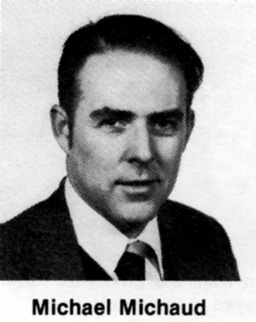
I
What will happen if we detect another civilization among the stars?
Many scientists who write about communication with extraterrestrial intelligence foresee a high-minded exchange of information, with an emphasis on science. Some, like Carl Sagan, argue that we will gain access to an "Encyclopedia Galactica". There have been suggestions that we will be the recipients of a one-way transmission of wisdom from superior civilizations.
This is heady stuff. It is exciting to imagine that our radio technology could pull the plug on some ocean of galactic knowledge, which would drain into a waiting human consciousness. But this scenario, while attractive, may be a case of predicting what we would like to happen, rather than a likely reflection of the first concerns of one civilization discovering another.1 (1. See, for example, Michael A.G. Michaud, "Interstellar Negotiation", Foreign Service Journal, Volume 49, (December, 1972), 10-14, 29-30. A slightly revised version titled "Negotiating with Other Worlds" appeared in The Futurist, Volume 7 (April, 1973), 71-77.)
Even if things work out this way, what will keep the cosmic dialogue going after the initial exchange of signals and basic data? There may be a driving force even more profound than a hunger for knowledge. In exchanging scientific information, communicating civilizations also will be exchanging perceptions of the position of intelligent life in the universe. To judge by our own experience, they might reach a common, depressing
conclusion: no matter how wise they are, these highly evolved forms all are doomed to eventual extinction when the universe ends in disorder. Their dialogue may revolve increasingly around one question: how can intelligent beings deal with this apparent fact, physically or philosophically?
II
According to our present understanding, intelligence can not aspire to eternal existence because the universe eventually will die, from a process that breaks down its structured energy and increases its disorder. Scientists measure this process as entropy.
We think there are two possible endings for the cosmos. In an open, expanding universe, structured energy will be dissipated into the general environment, eventually leaving a scattering of black holes, dead stars, and other bits of matter surrounded by a medium cooling slowly toward absolute zero. In a closed universe, the expansion will stop and
reverse to an infall, which will crunch everything together in a final singularity.
Our own history suggests that civilizations thrive on optimism and hope; this may be true of extraterrestrial civilizations as well. Yet those civilizations which study the nature of the universe will discover an iron law: that entropy steadily increases. That knowledge, as it seeps into the general consciousness, could be demoralizing, sapping the morale of the most advanced civilizations.
This is a matter of perspective, of course. The time needed for complete entropy — or universal thermodynamic equilibrium — would be extremely long by current human standards: tens to hundreds of billions of years in a closed universe, and much longer in an open one. But the philosophical question would remain: have life, intelligence, and civilization evolved only to become aware that they face eventual collective destruction? If so, what is the point of going on?
The physicist and mathematician Freeman Dyson has suggested an ingenious way to deal with the implications of growing entropy in an open universe.2 (2. Freeman J. Dyson, "Thinking Small in Space", paper presented at the annual meeting of the American Association for the Advancement of Science, Washington, D.C., February
15, 1978.) Since available energy will be gradually declining, Dyson proposes that intelligent beings (perhaps intelligent machines) replace themselves with successive generations which consume only half as much energy and think only half as fast. According to Dyson, this would allow intelligence to process information forever. However, even Dyson organisms would not survive the infall of a closed universe. And their scope for action in an open one would be narrowed steadily as usable energies declined.
III
Another approach is to use technology, the machines life creates, to challenge the entropic process. Life itself is a kind of anti-entropy, maintaining greater thermodynamic efficiency within its boundaries than exists outside them in the general environment. In an earlier issue of COSMIC SEARCH, Jerome Rothstein described life as a well-informed heat engine, and suggested that thermodynamic evolution will lead from systems of higher entropy to systems of lower entropy.3 (3. Jerome Rothstein, "Generalized Life", COSMIC SEARCH, Volume 1 (March, 1979), 35-38, 44-46.) Intelligent beings also can expand the volume of improved thermodynamic efficiency through their technologies, beginning with such simple things as clothing
and buildings.
We might suggest that technological civilizations could deliberately challenge their apparent fate by expanding the volumes in which they reduce or control entropy. In the long term, an expanding civilization might aspire to the ultimate command of mind over matter — an intelligently controlled universe. But there are at least two obstacles to any civilization achieving this.
There appear to be physical limits to how far any one civilization can extend its control over matter. Gale and Edwards studied this question and concluded that the "mass horizon" at which half the matter could be prevented from expanding might be 1.6 giga-light years away.4 (4. William A. Gale and Gregg Edwards, "Models of Long-range Growth", in William A. Gale, Editor, Life in The Universe: The Ultimate Limits to Growth, Boulder, Colorado, Westview Press, 1979, 71-106. (1 giga-light-year= 1 billion light-years).) This is an enormous distance, but it does not encompass all the universe.
An expanding civilization might encounter another civilization possibly engaged in the same activity. Inter-species communication could head off an unfortunate collision between these expanding volumes of reduced entropy. But it also might be used for something greater: cooperation, to jointly expand the volume directed by intelligence.
But even this is not enough. If our understanding of physical laws is correct, even cooperating civilizations will encounter a more fundamental problem. Reducing entropy within a given volume increases entropy in the environment around it. Creating more order within the zone of intelligent control creates more disorder outside it. This means that
even cooperating civilizations can never aspire to control the entire universe, and turn it into an intelligently controlled, thermodynamically efficient heat engine.
IV
Here we may have identified the ultimate dilemma facing technological civilizations. How do they escape the implications of eventual total universal entropy? A civilization which concludes that the task is impossible may decide that life is pointless, and awareness a cruel joke.
One of the most important functions of the intellectual leadership in an advanced civilization may be to counter this conclusion, to maintain optimism that somewhere, somehow a solution can be found. But this is a terrible burden, one that may not be
sustainable over the millennia. What is needed is an outside stimulus, and new perspectives on the problem. Communication with other civilizations could provide the hope, if not the solution. Together, communicating civilizations could keep up each other's spirits, while searching for the answer to this, the Last Question.
From our limited vantage point, we can only guess what that answer may be. Perhaps we — alone or in contact with other civilizations — will discover new physical laws that open up new routes to a solution. Perhaps we will find that the structure of
space-time we call the universe exists within a larger environment, which could absorb the increased disorder caused by our efforts to control our own cosmos.
If not, technological civilizations might seek instead to isolate their expanded volumes of order from the continuing process of universal entropy, so that they will not share the
fate of the rest of the universe. In this case, they would strive to create a bounded system which would not lose its energy to its environment, would not be drawn into a supermassive black hole or suffer heat death in an open universe, or would somehow escape the infall or recompression in a closed universe. In their final, most dramatic effort, intelligent beings might try to transfer this cocoon of thought out of our own cycle of fate to another place, such as a parallel universe, or another time in our own.
We do not know enough to be able to answer the Last Question. But other civilizations may be asking it as well, in exotic languages and alien modes of thought. By searching for
those other minds, we keep alive the hope of a new stimulus to our own thinking. It may be a congress of intelligence that will sustain optimism over the milennia, and someday reveal an answer.
It is exciting to imagine that our radio technology could pull the plug on some ocean of galactic knowledge which would drain into a waiting human consciousness.
It may be a congress of intelligence that will sustain optimism over the millennia and some day reveal an answer to The Last Question.

References are merged into article text.
 Michael Michaud is a professional diplomat and a writer with 62 published articles, book reviews, and stories to his credit. During the years 1976-78, he represented the
Department of State in U.S. Government studies of national space policy, and served on the U.S. delegation to the U.S.-Soviet Anti-satellite talks. Since 1972, he has written frequently on the question of extraterrestrial intelligence and on the future of spaceflight, with 36 published articles and papers on those subjects. He has spoken at a
number of meetings and conferences, and recently presented a paper to the Tenth Annual CETI Review Session at the International Astronautical Federation Congress in Rome, Italy. He was the author of "Extraterrestrial Politics" in the Summer 1979 issue of COSMIC SEARCH. Mr. Michaud presently is U.S. Consul-General in Belfast, Northern Ireland. The views expressed here are the author's.
Michael Michaud is a professional diplomat and a writer with 62 published articles, book reviews, and stories to his credit. During the years 1976-78, he represented the
Department of State in U.S. Government studies of national space policy, and served on the U.S. delegation to the U.S.-Soviet Anti-satellite talks. Since 1972, he has written frequently on the question of extraterrestrial intelligence and on the future of spaceflight, with 36 published articles and papers on those subjects. He has spoken at a
number of meetings and conferences, and recently presented a paper to the Tenth Annual CETI Review Session at the International Astronautical Federation Congress in Rome, Italy. He was the author of "Extraterrestrial Politics" in the Summer 1979 issue of COSMIC SEARCH. Mr. Michaud presently is U.S. Consul-General in Belfast, Northern Ireland. The views expressed here are the author's.
|
|
Putting the Cosmos on "Hold"
By: Frank D. Drake
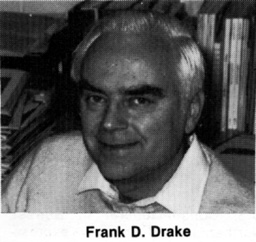 What is life for but to dream big dreams, and to work hard to make those dreams come true? This is a very human trait, and of all our modern dreams, one of the most tantalizing is to discover other worlds in space, to be spectators of other civilizations. What an adventure it would be — to know other intelligent creatures who have struggled
through an entirely different history! An impossible dream? As readers of COSMIC SEARCH know, it is within our grasp. The same know-how which has given us video-disks, communication satellites, and computers has quietly provided us with a powerful means to discover and study other civilizations in space. Indeed, for six years NASA has been quietly constructing a program of enormous promise to make a deeply sensitive search for the radio signals of other civilizations. Now, just as it is about to swing into full-scale action, this program, the Search for Extraterrestrial Intelligence (SETI), has been
given the axe by a single uncomprehending U.S. senator. As of October 1, 1981, new U.S. government funds for SETI have been abruptly terminated.
What is life for but to dream big dreams, and to work hard to make those dreams come true? This is a very human trait, and of all our modern dreams, one of the most tantalizing is to discover other worlds in space, to be spectators of other civilizations. What an adventure it would be — to know other intelligent creatures who have struggled
through an entirely different history! An impossible dream? As readers of COSMIC SEARCH know, it is within our grasp. The same know-how which has given us video-disks, communication satellites, and computers has quietly provided us with a powerful means to discover and study other civilizations in space. Indeed, for six years NASA has been quietly constructing a program of enormous promise to make a deeply sensitive search for the radio signals of other civilizations. Now, just as it is about to swing into full-scale action, this program, the Search for Extraterrestrial Intelligence (SETI), has been
given the axe by a single uncomprehending U.S. senator. As of October 1, 1981, new U.S. government funds for SETI have been abruptly terminated.
What is the U.S. SETI program? Designed by a group of top NASA scientists at the Ames Research Center and the Jet Propulsion Laboratory in California, and guided by a group of eminent university scientists, the program has been designed to apply the most modern
technology on large radio telescopes to search in depth in the "cosmic haystack" of almost countless stars and radio channels for intelligent signals. To make this possible, a special "spectrum analyzer" has been under construction by world-renowned experts at Stanford University. This device, when finished, can monitor almost ten million radio channels simultaneously for signs of intelligent signals. Attached to it will be a computer which can automatically analyze the data from the spectrum analyzer for a large
variety of forms of intelligent transmissions: television signals, radar pulses, spacecraft telemetry, or navigation signals, for example. This computer provides an "early warning" system, so that any sign of an extraterrestrial signal can be checked out right away. These devices not only speed up the pace of the search of the cosmic haystack immensely, but allow tests of a large fraction of all the radio channels where signals
might be expected, something which has not been possible before.
The plan has been to utilize the spectrum analyzer on NASA telescopes at Goldstone, California, to search the entire sky and many radio channels for ETI. Then the equipment is to be moved to the world's most sensitive telescope, at Arecibo, Puerto Rico and to a few other large telescopes to search particularly promising regions of our Milky Way galaxy, including the directions towards the nearest sun-like stars. Radiations no stronger than the strongest we radiate could be detected from distances of many thousands of light years. The entire program would take about seven years, and would require about $2 million per year, or about 1/3000 of the typical NASA annual budget. Even though we have already searched many millions of combinations of directions in the sky and frequencies for signals, this program would accomplish more than ten million times more searching than all previous searches put together. It would be an astonishing achievement, and the cost per test of the cosmos would be remarkably low.
Now, suddenly the walls have come tumbling down. Senator William Proxmire of Wisconsin, a powerful member of the U.S. Senate Appropriations Committee, has seen fit to attack the SETI program. He has launched criticisms of the SETI program which all readers of COSMIC SEARCH will easily find ludicrous. He asks, would not any signals we receive be many hundreds of years old, and therefore not of much interest? (Of course, the signals would probably be thousands of years old, yet would very probably originate from civilizations much more advanced than we, from whom we can learn much, to say the very least.) Might the signals even come from millions of light years away, and thus be from civilizations which may now be extinct, he asks? (Well, there are no stars at that range we might listen to — all the stars in the Milky Way are within 100,000 light-years. In any case, again the signals would contain priceless information from advanced civilizations. And after all, we even learn much from studying extinct civilizations such as those of the ancient Greeks and Romans!)
And what about the science fiction speculations that any advanced civilization at some point will build omnipotent robots which will fly to all the distant planets and colonize
them? In this scenario, since no such robots have come to the earth, we must be the first and only advanced civilization in the Milky Way. Then it's no use searching, he says. (Well, there are a lot of technical and sociological reasons why such robots don't make sense, as COSMIC SEARCH readers know. No matter what, they are more expensive than the wildest dreams, and return nothing to a civilization which cannot be obtained much more cheaply by other means. All it takes is one Senator Proxmire per civilization to scotch this idea, and I would place my bet that there are many of him!) In another thrust, he says there is no evidence for life in space. (True, and so there was no evidence for
America when Columbus proposed a little exploring. The analog is a very close one, only this time we have much better theories to support our proposals than did Columbus.)
Behind these questions there are no doubt some truly important concepts and questions, in fact some of the prime questions about extraterrestrial life. But these questions can
only be answered by scientific observation. In a universe as complicated as ours, no amount of theorizing will tell us the nature of life in the cosmos.
If They and Their signals are going to be there for millions of years what is the rush? Why not wait until the interest rates go down, suggests Senator Proxmire. The answer is obvious. We live in a troubled world in which economic and technical problems enhanced by our exploding population are looming as an awesome menace to our quality of life and even
our existence. We need to know all we can of our universe and of the social systems invented by other sentient beings. There is probably no quicker route to wisdom than to be the student of other civilizations. Furthermore, as humans, it is not enough just to survive, we need to enrich our lives with new knowledge, new vistas, just as our lives are enriched by music, sport, and travel, among other things. Without this a people loses its
pride, dignity, and motivation to succeed. Delaying SETI is no more reasonable than turning off all the music, all the plays, all the games until interest rates come down. Besides, on a practical side, the SETI team is assembled, and any hiatus in the program will lead to the dispersal of years of human development and will cause us to have to cope with an increasing level of manmade radio interference.
Yet Senator Proxmire feels he is qualified to make the scientific decision that SETI should no longer be sponsored. Using his seniority and his muddled scientific information, he has succeeded in passing a resolution which would stop all U.S. support for SETI at least for one year, and if he has his way, forever. It is an embarrassment particularly to American history that America would turn away from one of the most promising ventures a civilization can pursue. It reflects on America's political system that basically scientific decisions can be preempted by unqualified politicians instead of scientist administrators such as those who run NASA, one of the most successful scientific organizations of all time. How can this happen? Perhaps because it all makes good publicity back in Oshkosh and Milwaukee, and the chances of the senator's reelection are
enhanced, perpetuating a weakness in the system.
The ultimate irony is that while all of this has been taking place, Senator Proxmire has been frantically maneuvering to preserve excess subsidies to dairy farmers. Congress did not want this, but again he prevailed. The cost to the taxpayer, just for the excess subsidy, not the basic subsidy, is between $500,000 and $1,000,000 per day. Every two days enough funds to run SETI for a year are diverted to this end.
Will we eventually make the right decisions in a matter so minor financially, and yet so deeply profound in its significance? Or will this one bizarre episode delay our entrance into the galactic club? Will we have a chance to realize one of the most exciting of dreams we have dared to dream? Tune in next year, but not today. For now, Americans are not allowed to tune into the cosmos.
In a universe as complicated as ours, no amount of theorizing will tell us the nature of life in the cosmos. The answers can only come from scientific observation.

Based on an article by Frank Drake in the Miami Herald, October 11, 1981 — the day before Columbus Day
 Frank D. Drake is Goldwin Smith Professor of Astronomy at Cornell University and a member of the Editorial Board of COSMIC SEARCH. Famous for his Project Ozma and for the "Drake Equation", Dr. Drake is the author of many articles and books including "Intelligent Life in Space" (1967). His informative and provocative column has been a regular feature of COSMIC SEARCH since the Summer 1980 issue. His article "Reminiscence of Project Ozma" was featured in the premier issue of COSMIC SEARCH (January 1979).
Frank D. Drake is Goldwin Smith Professor of Astronomy at Cornell University and a member of the Editorial Board of COSMIC SEARCH. Famous for his Project Ozma and for the "Drake Equation", Dr. Drake is the author of many articles and books including "Intelligent Life in Space" (1967). His informative and provocative column has been a regular feature of COSMIC SEARCH since the Summer 1980 issue. His article "Reminiscence of Project Ozma" was featured in the premier issue of COSMIC SEARCH (January 1979).
|
|
The Extrasolar Planetary Foundation Report, The First year
October, 1981
By: George D. Gatewood
This report covers the first year's activities of the Extrasolar Planetary Foundation.
The Extrasolar Planetary Foundation was incorporated under the laws of the Commonwealth of Pennsylvania as a non-profit scientific foundation on September 19, 1980. Its stated purpose is to stimulate and financially support the scientific search for, and subsequent
study of, the planetary systems of other stars. The Foundation is governed by a Board of Directors who serve without pay. Members are Dr. Frank D. Drake, Mr. George C. Fennell, Dr. George D. Gatewood, Dr. Bruce Hapke, Mr. Allen P. Keeley, Dr. Joost H. Kiewiet de Jonge, Mr. C. Thomas Reiland, Ms. Nancy Nowakowski Robinson and Dr. John W. Stein. All members of the Board of Directors are active in various aspects of astronomy. Dr. Drake is a former Director of the Arecibo Radio Observatory and Professor of Astronomy at Cornell
University; Drs. Gatewood and Stein are directly involved in the planet detection effort having developed new instrumentation for astrometric investigations. Dr. Gatewood is also presently serving as the Director of the University of Pittsburgh's Allegheny Observatory. Dr. Hapke has been included on the scientific investigative teams of several interplanetary probes and is a Professor of Geology and Planetary Science at the University of Pittsburgh. Dr. Kiewiet de Jonge is a celestial mechanician and Associate Professor of Physics and Astronomy at the University of Pittsburgh. Also serving without pay are the members of the Advisory Panel, currently made up of Dr. Jane Russell of the University of Iowa and Dr. Allan Walstad of the University of Pittsburgh's Johnstown Campus.
For legal assistance, the Foundation has engaged the services of the respected Pittsburgh law firm of Reding, Rea and Cooper, who besides filing the articles of incorporation have petitioned the IRS for recognition of exemption under section 501 (C) (3) of the Internal Revenue Code. The Foundation has also opened an account with the Mellon Bank of Pittsburgh
and engaged the firm of Merrill Lynch, Pierce, Fenner & Smith as brokers.
Donations to the Foundation are carried in three specific funds, these are 1) Instrumentation, 2) Endowment, 3) Operational. It is Foundation policy that gifts
designated by the donor for specific purposes are set aside for those purposes and are not intermingled with operating, or any other funds. If this is not deemed possible, the gift is returned. The total receipts for the first year were rather impressive, but lopsided: $30,296 in cash, stocks, and equipment.
Gifts for operational expenses were, using our all volunteer staff (only our attorney receives any form of compensation for his services), sufficient for $330 of advertising, $108 for a small mailing campaign, $150 for a mailing list, $234 for brochures, and $127 for office and computer supplies. Legal and incorporation fees totaled $754.
Of the three funds, the one that fared most poorly was the endowment. Perhaps it is reasonable that a new organization should receive most of its contributions as start-up funds, but because it is this constantly growing principal that will give the Foundation the strength necessary to remain a strong influence in the active decades to come, it should not be overlooked entirely.
Our most spectacular success has been the instrumentation drive. Supported largely by a matching gift of up to $20,000 by Dr. Bernard Oliver of the Hewlett-Packard Corporation, we have now raised nearly $24,000 in cash and stock donations for the construction of
the first optical system with an accuracy sufficient to detect other planetary systems. $2,500 of this sum was donated by the CETI Foundation and other smaller donations totaled nearly $1,500. We are planning an additional mailing campaign and are currently in contact
with both the Planetary Society and Delta Vee, Incorporated, in an effort to match more of the funds offered by Dr. Oliver.
With these gifts and private monies received by the University of Pittsburgh, the effort to obtain a new objective lens for the 30-inch Thaw refractor is now within $26,000 of the $129,500 final total of the respective job bids. The largest single gift to this effort to date is only $8,000 larger than that collected so far by our Foundation. With $26,000 left to go, our organization has an opportunity to be the largest single contributor to the very first project related to its specific purpose. Not a bad way to begin.
Additional assistance to the Foundation came in the gift by Drs. Jaylee and Gilbert Mead of the Goddard Space Flight Center, of two small computer systems. The larger of these, complete with a printer, has taken up Foundation record keeping. The second computer is
currently being employed in software development for several computers mounted in the control room of the Thaw refractor. We currently are considering a request from another investigator for a computer terminal with spooling capabilities that this small computer may satisfy.
We would like to finish this report with an excerpt from one of the many letters of
support we have received during our first year:
"I am 43, and I certainly would like to see in my lifetime, incontrovertible evidence commanding universal recognition of the existence of specific extrasolar planetary systems ...... Next month, in accordance with the recently passed tax cut (which I oppose) my
withholding, as everyone elses, will be cut 5%. At my current $30,000 per year level of earnings and single status, this should amount to $400 the first year. I pledge this amount and challenge other supporters to do similarly."
We would certainly welcome all assistance with the task that lies ahead. With the support of those who have chosen, and will choose, to join the Foundation's growing list of patrons, we believe that having become an organization that has had a significant effect in its first year, the Foundation will go on to exert a profound influence in what will
become a major new human endeavor — the search for and study of other planetary systems.
George D. Gatewood, Chairman
Extrasolar Planetary Foundation
Observatory Station
Pittsburgh, Pennsylvania 15214
|
|
U.S. Space Policy
The Continuing Controversy
By: Marcia S. Smith
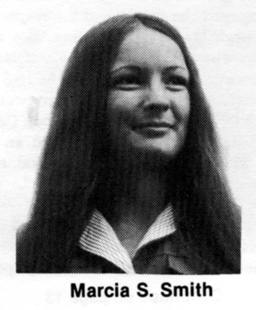
The Space Arena Is Becoming More Complex
1981 is proving to be a banner year for issues surrounding U.S. activities in outer space. The first flight of the shuttle not only reminded everyone that the United States does indeed have a space program, but that we use space for military as well as the better known civilian activities. The shuttle is increasingly being viewed — rightly or wrongly — as primarily a military rather than a civilian vehicle.
Developing policies and goals for DOD's (Department of Defense's) military and NASA's (National Aeronautical and Space Administration's) civilian space programs, and for interaction between the two, has become more important with tighter budgets, since many of the programs seem duplicative. At the same time, DOD's space budget has grown to where it is now almost equal to NASA's. With the advent of the space shuttle era, where both agencies will be using the same launch system, the lines between the two programs are blurring, and the possibility of merging them into one agency has become a popular topic of conversation.
Even as the Government role in space increases, the private sector's use is growing, too. Not only is a greater segment of private industry using space technology such as communications satellites, but it is becoming interested in operating space systems such as the shuttle and remote sensing satellites. One company has even built a launch vehicle to compete commercially with the Government's space shuttle for certain types of launches.
Concurrently, space is becoming more international in character. Virtually every country uses some type of space service (particularly communications satellites), and four other countries and one international organization have their own launch capabilities. The traditional rivalry between the United States and the Soviet Union for leadership in space is expanding to include Japan and the European Space Agency.
In 1982, the United Nations will sponsor UNISPACE-82, the second Conference on the Peaceful Uses of Outer Space, to review progress in space research since the last conference in 1967, with the focus on explaining the benefits of space research to less developed countries. Participation in the conference by the United States is uncertain, however, because of a dispute over who will serve in what capacity at the conference.
Sputnik
The space age began on October 4, 1957 with the Soviet launch of the first satellite, Sputnik I. Although it had been well known that both the United States and the Soviet Union were planning to attempt satellite launches as part of the activities of the International Geophysical Year (IGY), the Sputnik launch shocked western observers not only because it came earlier than expected, but also because the satellite weighed 84 kilograms, over eight times greater than the U.S. satellite then under development (Vanguard, which weighed 10 kilograms). This indicated a substantially greater launch capability than thought possible for Soviet technology. The shock tremors from Sputnik I had barely subsided when a second wave hit with the launch of Sputnik 2 on November 3.
Weighing 508 kilograms, the satellite had life support systems and carried the first animal, a dog, "Layka," into orbit.
In examining the reasons why the Soviets had beaten the United States into space, it became clear that at least part of the explanation was President Eisenhower's insistence that any U.S. satellite launched in support of the IGY be identified as a non-military program. While recognizing that there were valid military uses of space, the President wanted to present an image to the world of the United States fostering the peaceful uses of space. He chose the Naval Research Laboratory to develop a purely civilian launch vehicle, Vanguard, rather than using military IRBM (Intermediate Range Ballistic Missile) technology from the Army's Ballistic Missile Agency (ABMA). Even though ABMA was reportedly confident that it could have placed a payload into space during a test of the Jupiter C missile in September 1956, the President would not authorize the Army to fire the fourth stage of the rocket which might have accomplished that goal.
Even after Sputnik I, President Eisenhower still insisted that Vanguard be used to launch the first U.S. satellite, so the project was given higher priority. Nevertheless, the first "launch" of Vanguard on December 6, 1957 was an embarrassing failure. The vehicle lifted about one meter off the pad and then came crashing down to a fiery finale.
Recognizing the immediate need to establish the United States as at least the technological equal of the Soviet Union, President Eisenhower relented and gave ABMA permission to launch the Jupiter C rocket. The launch was successfully accomplished on January 31, 1958, carrying the 8 kilogram Explorer 1 satellite, which led to the discovery of the Van Allen radiation belts. Vanguard finally made its first successful orbital flight on March 17, 1958 carrying the 2 kilogram Vanguard satellite (leading to the discovery that the Earth is slightly pear-shaped).
President Eisenhower still wanted to maintain separate military and civilian space programs, however, and in a Special Message to Congress on Space Science and Exploration on April 28, 1958, he outlined his proposal to establish the National Aeronautics and Space Administration (NASA) to conduct the nation's civilian space programs. Under the plan, responsibility for military space activities would remain with the Department of Defense.
The President's proposal, as modified by Congress, was enacted into law three months later, on July 29, 1958, and created NASA as of October 1, 1958. Section 102(b) of the National Aeronautics and Space Act established the dual space program responsibilities which we have today:
The Congress declares that the general welfare and security of the United States require that adequate provision be made for aeronautical and space activities. The Congress further declares that such activities shall be the responsibility of, and shall be directed by, a civilian agency exercising control over aeronautical and space activities sponsored by the United States, except that activities peculiar to or primarily associated with the development of weapons systems, military operations, or the defense of the United States shall be the responsibility of, and shall be directed by, the Department of Defense ....
Some of the activities which had been conducted by the military services, such as ABMA's launch vehicle program, under the direction of Wernher von Braun, and the Jet Propulsion Laboratory, which built the Explorer satellite, were transferred to NASA.
The Space Act included a mechanism to coordinate activites between DOD and NASA — the Civilian/Military Liaison Committee — but it was abolished in 1965. Formal coordination between the agencies has been left primarily to the Aeronautics and Astronautics Coordinating Board, established by an interagency agreement in 1960, although informal mechanisms have always been an important part of the relationship between the two agencies.
Although there was some discontent within the military over the creation of NASA, and within the various military services themselves over who should have what jurisdiction over particular space activities, the military and civilian space programs had been given their marching orders. Whatever rivalries existed did so unofficially. In appearances before Congress, harmony was the watchword.
The Moon Mandate
President Kennedy's 1961 mandate to land Americans on the moon by the end of the decade shaped U.S. civilian space programs for all of the 1960s.
On May 25, 1961, three weeks after Alan Shepard became the first American in space, President Kennedy addressed the Congress.
... I believe that this nation should commit itself to achieving the goal, before this decade is out, of landing a man on the moon and returning him safely to earth. No single space project in this period will be more impressive to mankind, or more important for the long-range exploration of space; and none will be so difficult or expensive to accomplish ....
Congress and the Nation were willing to make the commitment. Space goals for the next decade were set — the Moon race was on.
While NASA concentrated on the Apollo program, and its other scientific and applications programs, DOD moved along with its activities in space. Some of these were similar to NASA's programs, such as meteorology, communications, and reconnaissance satellites (essentially earth resources satellites with substantially better resolution limits).
Even though some NASA and DOD programs seemed duplicative, and subsurface rivalry continued throughout the 1960s, both agencies were generally able to argue their own cases for space funding and programs. As time passed and the economic health of the nation declined, attitudes towards space programs changed. Since DOD's programs were not well known to the public, and had national security implications as well, it was NASA which was accused of gobbling up scarce dollars for questionable purposes. Three of the Apollo moon landings were cancelled, and the once ambitious Apollo Applications Program for orbiting space laboratories was scaled down to involve only one space station (Skylab) to which three crews were sent in 1973 and 1974.
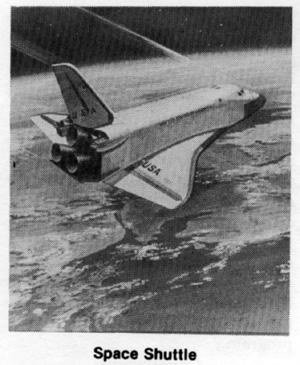 The focus of the civilian space program for the 1970s became development of a reusable space transportation system for carrying cargo back and forth to Earth orbit, called the space shuttle. In 1972, President Nixon gave the go-ahead for development of the shuttle as a national space system for both civilian and military users. The Department of Defense had input as to specifications for the shuttle (for example, how large the cargo bay shoud be), but it was primarily a NASA program. Since both DOD and NASA would be using the system, the questions of how costs should be shared and how the agencies would interact once the shuttle was in operation, arose as the program progressed.
The focus of the civilian space program for the 1970s became development of a reusable space transportation system for carrying cargo back and forth to Earth orbit, called the space shuttle. In 1972, President Nixon gave the go-ahead for development of the shuttle as a national space system for both civilian and military users. The Department of Defense had input as to specifications for the shuttle (for example, how large the cargo bay shoud be), but it was primarily a NASA program. Since both DOD and NASA would be using the system, the questions of how costs should be shared and how the agencies would interact once the shuttle was in operation, arose as the program progressed.
In 1978, President Carter addressed these issues in two Presidential directives. The first concerned the interaction between the various governmental space programs (NASA, DOD, Department of Commerce, etc.). Among other things, NASA was directed to pay virtually all the costs associated with development of the space shuttle, and DOD was given the authority to "bump" civilian payloads from scheduled shuttle flights if a DOD launch was required for national security purposes.
The second directive addressed goals for the civilian space program for the next decade, and was subsequently criticized for not specifying programs to accomplish those goals. Four bills were introduced in the 96th Congress addressing the need for a more definitive civilian space policy. Hearings were held in both the House and Senate, but none of the bills was reported from committee.
The Policy Debate Continues into 1981
The Carter administration decision to have NASA pay the majority of costs for the space shuttle (estimated at $9.9 billion through the end of the four test flights in 1982) placed severe strains on that agency's budget. In FY 1982, for example, the NASA budget request includes $2.2 billion for the shuttle, out of a total NASA budget (for space and aeronautics) of $6.1 billion. As a result, many other NASA programs have been cancelled, deferred, or simply not started. The Reagan budget request for NASA in FY 1982 resulted in cancellation or deferral of all new program initiatives in space science, applications, and aeronautics that had begun in FY 1981 or had been proposed for FY 1982.
Space science, which its supporters felt had suffered as a result of the Apollo program, has borne the brunt of funding restrictions caused by NASA's latest manned space program as well. Included among the cancelled space science programs was U.S. participation in a joint project with the European Space Agency (ESA).
The International Solar Polar Mission was designed to have two spacecraft (one United States and one European) for simultaneous observations of the north and south poles of the sun. The U.S. decision to abrogate its agreement with ESA on this program was not formally discussed prior to its announcement, and chilled relations between the two groups. The full implications of this action for future international cooperation in space are not yet known. (Congress may restore funding for U.S. participation in this mission).
The space budget of the Department of Defense is now almost equivalent to the whole of NASA's budget. The FY 1982 request is $5.8 billion, of which $538 million is for DOD's part of the shuttle program (an additional $419 million is requested for the inertial upper stage and construction of a shuttle launch facility at Vandenberg Air Force Base, California). In addition, DOD is constructing a Consolidated Space Operations Center (CSOS) near Cheyenne Mountain, Colorado for command and control of military shuttle flights (it will also backup NASA's shuttle control facility at Johnson Space Center).
Other DOD space programs include satellites for reconnaissance (photographic, electronic, ocean surveillance, nuclear explosion detection, and early warning), meteorology, navigation, and communications (at the present time approximately 70 percent of U.S. overseas military communications are routed through space). DOD is also developing an "antisatellite" (ASAT) device which can be used to destroy enemy satellites by launching a small missile from an F-15 aircraft (the Soviet Union already has an operational ASAT capability using a different type of system).
The Reagan administration has begun its own interagency review of space, although no timetable for a completion of the study has been announced. In Congress, the subject continues to receive attention, and two bills have been introduced to set a new civilian U.S. space policy. On May 28, Rep. George Brown reintroduced his space policy bill from the 96th Congress (H.R. 3712), and on July 28, Rep. Newton Gingrich introduced the "National Space and Aeronautics Policy Act of 1982" (H.R. 4286).
In addition, a congressional staff space group has been established to provide a forum for Members and their staffs who are interested in space. One goal of the group, which is also enunciated in the Gingrich bill, is to support construction of permanent Earth-orbiting space stations. NASA has shown a strong interest in making such a station its next manned space priority. There is also a growing interest in increasing private industry's direct participation in space activities.
The relationship between the military and civilian space programs has not yet been directly addressed by recent legislative initiatives in the Congress, although it has been discussed in hearings on space policy in general. The views expressed in hearings reinforce the separation between military and civilian space activites. For example, in its report on 1980 space policy hearings, the House Science and Technology Committee's Sub-committee on Space Science and Applications recommended that "The civil and military space programs should be examined separately and their funding adjusted according to the requirements developed for each program."
Conclusions
The views of space policy planners in 1981 regarding the separation of military and civilian space activities seem to parallel those of 1958. The idea of separating the programs to demonstrate U.S. interest in using space for peaceful purposes still seems valid today, despite the growing military role in space. Perhaps of greater concern, though, is that military programs might overwhelm those not within the purview of NASA if both were managed by the same agency.
The line between military and civilian activities, however, is becoming increasingly blurred. The space shuttle is the main cause for this, since it will be the single launch vehicle used for all U.S. space activities. The Soviet Union has publicly stated its view that the shuttle is a military vehicle, an opinion which has been expressed in other quarters as well. The shuttle will, in fact, have a significant military role, not only in carrying DOD satellites into orbit, but in programs such as Talon Gold (which is related to developing technology which may be applicable to space-based lasers). Whether or not Congress will formally review the issue of maintaining separate civilian and military programs is unknown, but the question may lose impact if NASA's programs continue to be cut and DOD's continue to be increased.
The question of needing a new civilian space policy, which would certainly help NASA retain its separate identity, is likely to be addressed by those committees of Congress with jurisdiction over NASA authorizations, if not the whole Congress.
The magnitude and character of space activities is growing and changing throughout the world. A reassessment of what U.S. space policy should be to best take advantage of this climate may assume added importance as the U.S. military role expands, and the space shuttle continues through its series of test flights, the second of which was November 12-14, 1981, with the third scheduled for this spring.

References for further reading:
Grey, Jerry, "Enterprise", the inside story of the Space Shuttle. William Morrow and Co.,
1979.
Available from U.S. Gov't Printing office:
Smith, Marcia S., et. al. United States Civilian Space Programs: 1958-1978. Committee Print, 1981 (House Committee on Science and Technology). 1339 pp.
U.S. Congress. House. World-Wide Space Activities. Committee Print, 1977. (House Comittee on Science and Technology) 607 pp.
Available from your member of Congress:
Sheldon, Charles S. United States and Soviet Progress in Space: Summary Data Through 1980 and a Forward Look. January 15, 1981. CRS Report No. 81-27 S. 92 pp.
Smith, Marcia S. Antisatellites (Killer Satellites). Issue Brief 81123.
Smith, Marcia S. Space Policy and Funding: NASA and DOD. Issue Brief 78093.
Smith, Marcia S. Space Shuttle. Issue Brief 73019.
Note: "U.S. Space Policy" is an abridged version of Marcia Smith's article which was featured in the September 1981 issue of the "Congressional Research Service REVIEW" to which readers should refer for more details. Reproduced by permission.
Comment: Although not widely known, Russia was in the race to the Moon until, after several spectacular launch disasters of gigantic Moon-rockets, it withdrew.
— Ed.
 Marcia S. Smith is a specialist on Aerospace and Energy Systems for the Science Policy Research Division of the Congressional Research Service (CRS), the non-partisan research branch of the United States Congress. In this capacity since 1975, she acts as a consultant to Members and Committees of Congress on issues concerning the space programs of the U.S. and other countries. She is author of more than two dozen reports and articles on the space program, including the "Possibility of Intelligent Life Elsewhere in the Universe" written for and published by the Committee on Science and Technology of the House of Representatives. She received her Bachelor's degree from Syracuse University in 1972 and is a member of numerous scientific societies. Her informative article Confronting Political Realities; The Federal Funding Process: A SETI Case History" was featured in the Summer 1980 issue of COSMIC SEARCH.
Marcia S. Smith is a specialist on Aerospace and Energy Systems for the Science Policy Research Division of the Congressional Research Service (CRS), the non-partisan research branch of the United States Congress. In this capacity since 1975, she acts as a consultant to Members and Committees of Congress on issues concerning the space programs of the U.S. and other countries. She is author of more than two dozen reports and articles on the space program, including the "Possibility of Intelligent Life Elsewhere in the Universe" written for and published by the Committee on Science and Technology of the House of Representatives. She received her Bachelor's degree from Syracuse University in 1972 and is a member of numerous scientific societies. Her informative article Confronting Political Realities; The Federal Funding Process: A SETI Case History" was featured in the Summer 1980 issue of COSMIC SEARCH.
|
|
The First 50 Years of Radio Astronomy,
Part 2: Grote Reber and the First Radio Maps of the Sky
By: John Kraus
"I think it's for collecting rain water."
"No, I think it's a device for controlling the weather."
"Well, whatever it is, it's the strangest contraption I've ever seen in a Wheaton backyard."
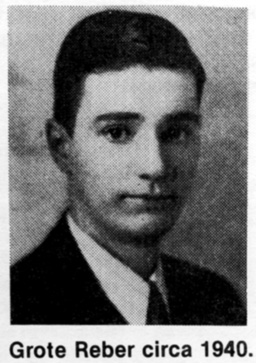
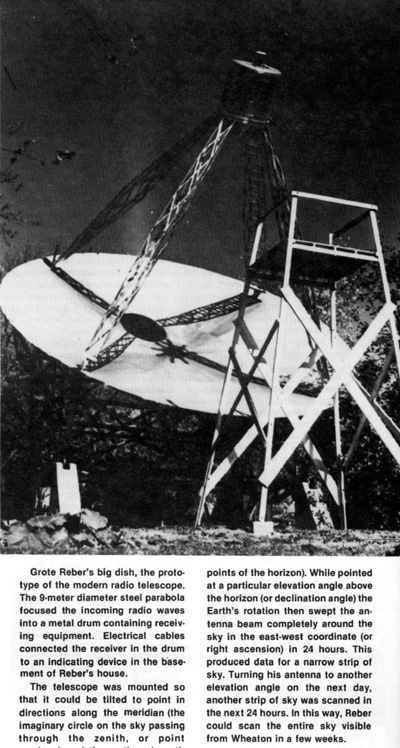 The residents were puzzled but the neighborhood children were delighted, for there in Grote Reber's backyard was something more fun to climb than any jungle-gym they'd seen before. Towering three stories high was a huge steel saucer supported from below by a network of wooden timbers and trusses. Designed and built by Grote Reber during the summer of 1937, it was the forerunner and prototype of the modern radio telescope. With it Reber soon began to follow up on Karl Jansky's discovery of radio waves from our galaxy and for a decade Reber was the world's only active radio astronomer, keeping a lonely vigil of
the heavens and producing the first maps of the radio sky.
The residents were puzzled but the neighborhood children were delighted, for there in Grote Reber's backyard was something more fun to climb than any jungle-gym they'd seen before. Towering three stories high was a huge steel saucer supported from below by a network of wooden timbers and trusses. Designed and built by Grote Reber during the summer of 1937, it was the forerunner and prototype of the modern radio telescope. With it Reber soon began to follow up on Karl Jansky's discovery of radio waves from our galaxy and for a decade Reber was the world's only active radio astronomer, keeping a lonely vigil of
the heavens and producing the first maps of the radio sky.
Karl Jansky's discovery of radio waves from our galaxy* (* Part 1. COSMIC SEARCH, Fall 1981, Serial no. 12, page 8.) was an historic event. With his merry-go-round antenna he opened a new window on the cosmos, a discovery that ranks with the works of Copernicus and Galileo.
Jansky was well aware of his discovery's importance. He wanted to follow up with further studies of his "star static" over a range of wavelengths; he wanted to build a 30-meter diameter steerable parabolic dish antenna to map the source of the radiation in more detail. But he obtained no support for his proposals. He even considered going to Iowa State University, where he hoped, in a university atmosphere, he might be able to pursue his interest but nothing came of it. And, no one else followed up immediately on his discovery so his momentous break-through, born in a fallow potato field, lay fallow on the world for several years.
But by 1938 Grote Reber had begun his observations in Wheaton, Illinois. A graduate of the Illinois Institute of Technology in 1933, Reber was a radio engineer and avid radio amateur. From his amateur station, W9GFZ, he had communicated with other amateurs in more than 60 countries on all continents and he looked for more distant conquests. Would it be possible, he wondered, to beam a pulse of radio waves to the Moon and receive an echo? He made elaborate plans and actually a few unsuccessful attempts until additional calculations convinced him that he would require more transmitter power than the one
kilowatt to which U.S. amateurs are restricted. In his Moon bounce experiment Reber anticipated by a dozen years Jack DeWitt's successful experiment with much more powerful equipment.* (* See COSMIC SEARCH, No. 7, page 27; also "Our Cosmic Universe" by John Kraus, Cygnus-Quasar Books, 1980, page 152.) But Reber had read Jansky's articles in the "Proceedings" of the Institute of Radio Engineers, the radio waves Jansky had discovered spanning the vast distances from the depths of our galaxy whetting his interest.
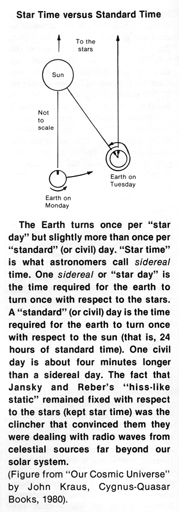 The big 9-meter diameter steel dish in his backyard was Reber's antenna for collecting Jansky's "star-static" or what Reber preferred to call "cosmic static". The radio energy from the antenna was focussed into a receiver which in turn operated a meter that indicated the strength of the hiss static. Collectively, the antenna, receiver and indicator constitute a "radio telescope".
The big 9-meter diameter steel dish in his backyard was Reber's antenna for collecting Jansky's "star-static" or what Reber preferred to call "cosmic static". The radio energy from the antenna was focussed into a receiver which in turn operated a meter that indicated the strength of the hiss static. Collectively, the antenna, receiver and indicator constitute a "radio telescope".
At the time of Jansky's discovery, the most likely explanation of the celestial radio radiation was that it was of a thermal origin, from hot objects, and should be stronger at shorter wavelengths. So on this assumption Grote Reber designed and built his first receiver to operate at 9 centimeters, the shortest wavelength it was practical to use at that time.
To build a receiver for this short wavelength required a great deal of experimental work by Reber involving tests on the many components he planned to use. By the spring of 1938 his entire system, antenna, receiver and indicator, was operational and Reber began systematic observations of the sky. Reber set his antenna to scan our galaxy, the Sun, the Moon, Jupiter, Venus, Mars and some of the brighter stars but all without any sign of an indication. At 9 centimeters thermal radiation should be 25,000 times stronger than it was at Jansky's wavelength and Reber's equipment should have readily detected it. So from this experiment Reber was able to draw an important conclusion: the radiation from our galaxy was not thermal. The science of radio astronomy had taken a first step.
Next, Reber decided to try the longer wavelength of 33 centimeters. It was not merely a matter of retuning the 9 centimeter receiver. An almost entirely new receiver had to be designed and built. He had this unit working by the autumn of 1938 but observations of all the previously examined objects in the sky again brought negative results. Reber began to wonder if the galactic radiation might behave just the opposite to thermal radiation and become stronger at longer wavelengths?
So once again he set about constructing another receiver for the still longer wavelength of 1.9 meters. At this wavelength Reber found that the ignition systems of passing automobiles produced a severe interfering static or popping noise but late at night this trouble was absent and by April 1939 he obtained strong indications of cosmic static from the center of the Milky Way! His antenna was pointing to the southern sky for these observations. Swinging his antenna further north he found that the cosmic static became weaker, thus confirming Jansky's findings in a general way.
All this while Grote Reber worked by day designing radio receivers at a nearby factory. After supper he slept until midnight, and then until he left for work the next morning, he sat in his basement beside the receiver and recorded the output meter readings at one minute intervals. On weekends he had the opportunity to record data at other times but during the daytime the automobile ignition interference prevented him from making good observations. During the summer of 1939 Reber pointed his antenna at many other celestial objects but found nothing besides the Milky Way radiation.
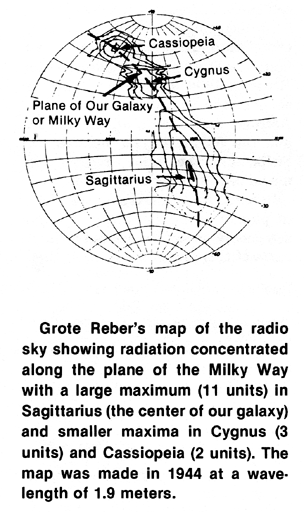 Encouraged by his detection of the galactic radiation, Reber next made several improvements in his receiver and purchased an automatic recorder giving a pen trace on a moving paper chart. No longer would he have to sit up all night recording data. With these changes Reber then embarked on the first systematic survey of the radio sky in 1941.
Encouraged by his detection of the galactic radiation, Reber next made several improvements in his receiver and purchased an automatic recorder giving a pen trace on a moving paper chart. No longer would he have to sit up all night recording data. With these changes Reber then embarked on the first systematic survey of the radio sky in 1941.
Then, for a while Reber left Wheaton to do research on protection devices for ships at the Naval Ordnance Laboratory in Washington, D.C. I was also doing similar research at the Naval Ordnance Laboratory. Reber and I stayed at the same rooming house where he told me about his equipment and observations of the Milky Way with a contagious enthusiasm. If we had not been at war I think I would have started building a radio telescope then. But it was not until 10 years later at the Ohio State University that I had a chance to do it.
Returning to his job in Illinois, Reber undertook a more complete survey of the sky in 1943. He also detected very strong radio waves from the sun.
The radio maps Reber made showed clearly the concentration of radiation along the plane of the Milky Way. The strongest radiation came from the center of our galaxy, in Sagittarius, with other less strong maxima or "hot spots" in Cygnus and Cassiopeia. The sources of the Cygnus and Cassiopeia radiation were later found to be extremely distant objects, the one in Cygnus an exploded galaxy at a distance of one billion light-years.
Although Jansky's merry-go-round antenna was physically larger than Reber's, the Wheaton antenna operated at a much shorter wavelength giving Reber better resolution or ability to separate and pin-point objects in the sky. Thus, the beam width or resolution angle of Jansky's antenna was about 30° whereas Reber's was about 12°. Later when Reber went successfully to a wavelength of 62 centimeters, he sharpened his antenna's resolution angle to about 4°.
Grote Reber published many articles about his results, most of them in the "Proceedings" of the Institute of Radio Engineers but also some in other professional journals. One of his articles entitled "Cosmic Static" was published in the June 1940 issue of the "Astrophysical Journal" and thereon hangs a tale.
When Reber submitted this article to the "Astrophysical Journal" it was the first time an article reporting radio emission from the sky had been submitted to an astronomical publication. The "Astrophysical Journal" was, and is, a refereed journal, that is, manuscripts submitted to it are sent to anonymous third party experts for their appraisal. Accordingly, Dr. Otto Struve, the journal editor sent Reber's manuscript to a number of referees. Astronomer referees returned Reber's manuscript with the comment that they didn't understand the radio terminology. Radio engineer referees returned the manuscript stating that they didn't grasp the astronomical implications. So Struve found no reviewer willing to defend the paper or recommend its publication.
Noting that Reber was a member of the Institute of Radio Engineers, Struve wrote in desperation to the Institute headquarters to find if it had any information about Reber's qualifications and reputation.
In due time Struve received a reply which stated that Grote Reber was a member in good standing of the Institute of Radio Engineers and that he paid his dues regularly!
At this point Dr. Struve was in a quandry. He had ample grounds for rejecting Reber's contribution; but reasoning that a good article rejected would be a greater evil than a poor paper accepted, he approved Reber's article for publication.
In 1940, when the article finally appeared, World War II was in progress, and Holland had fallen under Nazi occupation. But eventually a copy of the "Astrophysical Journal" carrying Reber's article reached the observatory at Leiden.
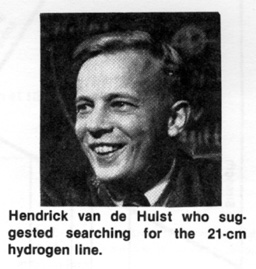 The article came to the attention of Hendrick van de Hulst, a young astronomer at the Leiden Observatory, who recognized that the radiation Reber and Jansky had observed must extend continuously over a wide range of wavelengths. In addition to this ubiquitous radiation that is like the hissing one hears all across the dial of a radio receiver when no stations are on the air, van de Hulst wondered if there might also be some radiation at a single wavelength, like from a radio station that comes in at a single point on the dial. So he investigated whether any theories might predict that some of the matter in space would have a single wavelength or "line radiation". In 1944, van de Hulst reported at a Leiden Observatory colloquium that hydrogen, the most abundant element in space, was a likely candidate. It had a natural wavelength of 21 centimeters corresponding to two different conditions of the atom's single electron. When the condition changed, the atom would emit a brief pulse or "beep" of 21 centimeter radiation, or under other circumstances it would absorb or act as a receiver for this same wavelength. Although the emission of a beep from a particular hydrogen atom might occur only once in million years, van de Hulst thought that there might be enough hydrogen in some regions of space that the combined beeps of the vast numbers of hydrogen atoms could be detected, and he suggested that a search be made.
The article came to the attention of Hendrick van de Hulst, a young astronomer at the Leiden Observatory, who recognized that the radiation Reber and Jansky had observed must extend continuously over a wide range of wavelengths. In addition to this ubiquitous radiation that is like the hissing one hears all across the dial of a radio receiver when no stations are on the air, van de Hulst wondered if there might also be some radiation at a single wavelength, like from a radio station that comes in at a single point on the dial. So he investigated whether any theories might predict that some of the matter in space would have a single wavelength or "line radiation". In 1944, van de Hulst reported at a Leiden Observatory colloquium that hydrogen, the most abundant element in space, was a likely candidate. It had a natural wavelength of 21 centimeters corresponding to two different conditions of the atom's single electron. When the condition changed, the atom would emit a brief pulse or "beep" of 21 centimeter radiation, or under other circumstances it would absorb or act as a receiver for this same wavelength. Although the emission of a beep from a particular hydrogen atom might occur only once in million years, van de Hulst thought that there might be enough hydrogen in some regions of space that the combined beeps of the vast numbers of hydrogen atoms could be detected, and he suggested that a search be made.
Seven years later, Harold Ewen and Edward Purcell of Harvard University detected the 21 centimeter hydrogen line radiation coming, as did Jansky's all-wavelength radiation, from the center of our galaxy. Within weeks it was also detected by other radio observatories in Holland and in Australia.
Observations of the hydrogen line have been of immense value, and research at this wavelength has become one of the most important and active phases of radio astronomy. One of the most spectacular results has been the mapping of the structure of our galaxy. These developments will be discussed in a later installment.
In retrospect, Reber's article, which might not have been published at all, turned out to be one of the classic articles of radio astronomy and also an important catalyst in the formation of a new field of research dealing with the 21 centimeter hydrogen line.

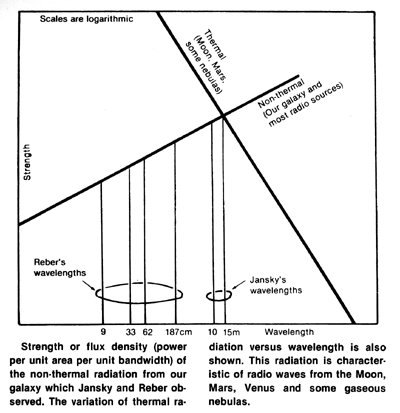
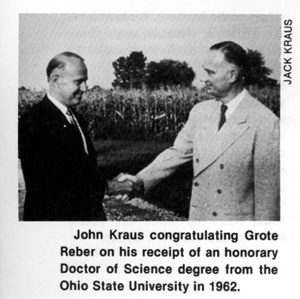 Reber fills an important niche in the history of science. He was the first to follow up on Jansky's work and extend it, laying the foundations of the new science of radio astronomy, and for a decade he alone nurtured and developed it. Reber's telescope is the prototype of the modern radio telescope. By observing the cosmic static at new wavelengths Reber demonstrated that it extended over a wide spectrum. By failing to detect it at sufficiently short wavelengths he was able to conclude that the cosmic static was not of thermal origin. It was later explained as coming from electrons in nearly empty space moving at high velocity in magnetic fields. Reber drew the first maps of the radio sky showing the strongest radiation coming from the center of our galaxy, confirming Jansky's result. Reber's maps also showed other regions of strong radiation in Cygnus and Cassiopeia. His numerous articles began to draw the attention of astronomers and one of his articles was the stimulus that resulted in the prediction and detection of the 21 centimeter hydrogen line.
Reber fills an important niche in the history of science. He was the first to follow up on Jansky's work and extend it, laying the foundations of the new science of radio astronomy, and for a decade he alone nurtured and developed it. Reber's telescope is the prototype of the modern radio telescope. By observing the cosmic static at new wavelengths Reber demonstrated that it extended over a wide spectrum. By failing to detect it at sufficiently short wavelengths he was able to conclude that the cosmic static was not of thermal origin. It was later explained as coming from electrons in nearly empty space moving at high velocity in magnetic fields. Reber drew the first maps of the radio sky showing the strongest radiation coming from the center of our galaxy, confirming Jansky's result. Reber's maps also showed other regions of strong radiation in Cygnus and Cassiopeia. His numerous articles began to draw the attention of astronomers and one of his articles was the stimulus that resulted in the prediction and detection of the 21 centimeter hydrogen line.
Reber is unique among scientists in that he plans his experiments with meticulous care, designs and builds most or all of his apparatus himself, makes his own observations, plots and interprets his data himself and compares his results, where possible, with theory. In a word, Reber conducts all aspects of his research; he was, and still is, a one man largely self-supported scientific laboratory. In recognition of his genius the Ohio State University conferred an honorary Doctor of Science degree on Reber in 1962. In the same year he received the Bruce gold medal of the Astronomical Society of the Pacific and the following year he was the recipient of the Elliot Cresson gold medal of the Franklin Institute.
Reber has continued over the years to pioneer in special areas of radio astronomy as will be related in later parts of this series.

Partial list of Grote Reber's publications prior to 1946
"Electromagnetic Horns", Communications, Feb. 1939, p. 13.
"Cosmic Static", Proceedings Institute of Radio Engineers, Feb. 1940, p. 68.
"Cosmic Static", Astrophysical Journal, June 1940, p. 621.
"Cosmic Static", Proceedings Institute of Radio Engineers, Aug. 1942, p. 376.
"Cosmic Static", Astrophysical Journal, Nov. 1944, p. 279.
"Reflector Efficiency", Electronics Industry, July 1944, p. 101.
"Solar Radiation at 480 Mc/sec", Nature, Dec. 28, 1946, p. 945.
|
Historical Sidelights
Edwin Hubble in Pasadena, California, was just reaching his dramatic conclusions that we lived in an expanding universe when Karl Jansky at Holmdel, New Jersey, was puzzling over charts recorded with his merry-go-round antenna. Soon thereafter Grote Reber began measuring what he called "cosmic static" with his backyard parabolic dish in the Chicago suburb of Wheaton.
Edwin Hubble and Grote Reber — could there be more than a cosmic connection between them, both being astronomers, one optical and the other radio? Yes, it turns out, there is.
Around 1900 the Hubble family lived in Wheaton, Illinois, and as his 7th and 8th grade teacher young Edwin Hubble had a Miss Harriet Grote who later married Schuyler Reber and bore him Grote Reber as their first son. She often commented to Grote that young Edwin Hubble stood out from other students in his class and that she felt he would go far. In later years, when Hubble's fame was spreading she took special pride in his accomplishments and that she had been his teacher.
Reprinted from "Big Ear" by John Kraus, Cygnus-Quasar Books, 1980.
•
About 1930, Gordon Stagner, a young radio operator at the Manila, Philippines, RCA station noticed that, in the absence of thunderstorm static, the hiss noise he heard on some short-wave antennas was much higher than on others. He was puzzled and wanted to investigate the matter but was told to stop wasting his time worrying about it and nothing more came of it. But when Karl Jansky's articles appeared in the "Proceedings" of the Institute of Radio Engineers a year or so later, Stagner realized what was going on; the strong hiss noise had occurred on those antennas directed toward the center of our galaxy.
•
In the 1930s; the idea of radio waves from celestial objects was foreign to the thinking of most astronomers. Radio waves were a million times longer than the light waves of the visible spectrum and the observational techniques were radically different. Even so, a number of astronomers recognized the significance of Jansky's discovery although they were not in a position to do much about it.
It was reported by Karl Jansky's father that at a University of Wisconsin astronomy colloquium he attended in 1933, Joel Stebbins commented that physicists might not be interested in Karl Jansky's discovery but astronomers certainly should be since the point in the sky where the signal was coming from was the point which astronomers believed to be the center of our galaxy. Stebbins, famous for his work measuring star light with photocells, was Professor of Astronomy and for many years Director of the university's Washburn Observatory.
According to George C. Southworth, famous for his waveguide research at Bell Laboratories, it was not until after Grote Reber "literally drew them a picture" of the radio sky that astronomers generally began to appreciate what Jansky had started.
|
|
THE FIRST 50 YEARS OF RADIO ASTRONOMY
by John Kraus
Part 1. "Karl Jansky and His Discovery of Radio Waves from Our Galaxy." COSMIC SEARCH (No. 12).
Part 2. "Grote Reber and the First Radio Maps of the Sky." This issue of COSMIC SEARCH. (No. 13).
Part 3. "Post-War Radio Astronomy." An emerging science with more radio astronomers than radio sources. The hydrogen line and the first maps of the galaxy. Cygnus A. Cassiopeia A. COSMIC SEARCH (No. 14).
Part. 4. "Radio Astronomy in the 1960's." Quasars, pulsars, Big Bang Background, Molecules in space, the Cambridge survey. COSMIC SEARCH. (No. 15).
Part 5. "Radio Astronomy in the 1970s, 80s and Beyond." COSMIC SEARCH (No. 16).
|
|
Note. Due to the cancellation of publication of COSMIC SEARCH following Issue 13, Parts 3, 4 and 5 of THE FIRST 50 YEARS OF RADIO ASTRONOMY were not published.
Jerry Ehman, Webpage Editor
|
|
|
Faraday - Maxwell - Jansky
(1831-1931)
By: John Kraus
In 1831 Michael Faraday, in London, discovered that plunging a bar magnet into a coil of wire produced an electric current. This discovery complemented the one by Hans Christian Oersted twelve years earlier in Denmark that a compass needle was deflected by a current-carrying wire. Thus, Oersted found that electricity produced magnetism while Faraday found that magnetism could produce electricity. These discoveries were the stepping stones by which James Clerk Maxwell, born in 1831, later propounded his laws relating electricity and magnetism. And from these basic beginnings have come our whole modern world of electric light, heat, power, refrigeration, motors, generators,
telephone, telegraph, radio, TV and a host of other developments we now take for granted.
One of these more recent developments is radio astronomy stemming from the discovery by Karl Jansky in 1931 of radio waves from our galaxy. The Fall 1981 issue of COSMIC SEARCH (Serial No. 12) commemorated the 50th anniversary of Karl Jansky's discovery. It could equally well commemorate the
150th anniversary of Faraday's discovery and Maxwell's birth.
By 2031, 200 years after the Faraday-Maxwell date and 100 years after Jansky's, will there have been
any new discoveries that will match theirs?
|
|
Why Explore? Hail Columbia!
By: John Kraus
In my book "Big Ear", I relate how in a 1960 Commencement Address at a large university I said,
"The conquest of nature and the unknown constitutes an endless frontier that will challenge man as long as he is capable of thinking and wondering.
"If man no longer searches for knowledge and truth, he is no longer man."
We explore because it is part of our basic nature. Exploration is our heritage and our destiny depends on it.
Norman Cousins once commented that being asked why we explore is like having to apologize for our highest attributes one of which is that we are, by nature, creatures of exploration.
The roots and tendrils of a plant are its explorers. Without them the plant dies. Humanity too needs its explorers else it will wither and die.
We are one with the universe and the universe is one with us. We will not know us until we know the universe.
And to know the universe we need to get into space. Space is our great frontier awaiting exploration and utilization.
In this issue's "ABCs of Space" I point out that "NASA holds the key to our future more than any other federal agency. What NASA plans now and can subsequently accomplish will determine where the U.S. will be 10, 20, 50 and 100 years from now, not just in space but with respect to our entire economy.
When we spend money on space we are really spending it right here at home but even more important than that is the fact that if we don't spend it on space we won't have it to spend at home.
The countries of the past that advanced at home were the sea-faring nations that advanced at sea.
The countries of the future that will advance at home will be the space-faring nations that advance in space.
The epoch-making flights of the Vikings and Voyagers to Mars, Jupiter and Saturn and the sensational trips into orbit and back by the reusable Space Shuttle Columbia are extraordinary achievements in the history of mankind. But few people appreciate or understand the immense difficulty and enormous complexity of these feats.
I am dismayed at the critics of our space program who say that we should hold back, and who sieze on every problem that arises to support their contention.
Every advance has had its critics; every achievement has had its detractors. But who remembers now the ridicule heaped on Secretary of State Seward's purchase of Alaska from Russia? "Seward's Icebox" it was called. Or who remembers that the telephone used to be called "Bell's Folly". And when you flick a switch and a room floods with light, who recalls Edison's thousands of failures before a first success? Or on seeing the Columbia cleave the sky on lift off, who remembers the hundreds of failures Goddard experienced before his rocket rose above the trees? And if Wilbur and Orville Wright had postponed work on their flying machine because "heavier-than-air craft are not practical" we might only now be getting out of the open cockpit era. If we don't build the best we can now and learn from it we won't have a better device later.
Those who can, do. Those who can't, criticize.
If the U.S. is to advance at home it must advance into space. Other nations are moving out into space and the question now is:
Is the U.S. going to be the premier space-faring nation or just a second or third-rate one or even become an Earth-locked nation?
I say, Hail Columbia! Hail to our pioneering spirit! Let's look to the future and be supportive of our space program. Space beckons.
John Kraus
|
|
Impressions of Voyager 2 and Saturn — A Report
By: David W. Swift
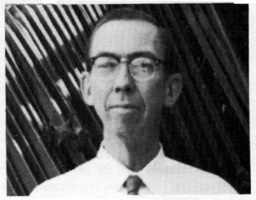 It seemed strangely familiar: the parched, barren hills around Arroyo Seco, the crowds, the lines of cars, police directing traffic, signs pointing to the Rose Bowl — all recalled the last time I had been in Pasadena, more than thirty years ago, to watch the famed football tournament.
It seemed strangely familiar: the parched, barren hills around Arroyo Seco, the crowds, the lines of cars, police directing traffic, signs pointing to the Rose Bowl — all recalled the last time I had been in Pasadena, more than thirty years ago, to watch the famed football tournament.
Then tens of thousands of people had crowded into the stadium to watch a small piece of leather being moved back and forth on a field a hundred meters long.
Now, a few miles away at Jet Propulsion Laboratory (JPL), scientists, spectators and a thousand members of the press had assembled because of another inanimate object. This one was more than a billion kilometers away, ten times farther than the Sun, racing toward Saturn at 70 thousand kilometers an hour. The spacecraft was so far away that radio messages traveling at the speed of light took an hour and a half to reach it, or us — light from the sun, traveling at the same rate, takes only eight minutes. Yet far more people were watching the distant encounter than had seen the early Rose Bowl games at the dawn of the television era, for Voyager 2's exploration of the ringed planet was being televised across the nation and carried to many other countries.
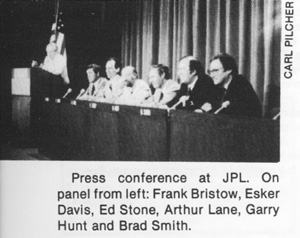
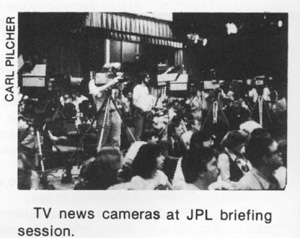 In addition to the crowds at JPL, thousands more were nearby in downtown Pasadena attending Voyager exhibits and activities presented by the Planetary Society, an organization formed by Carl Sagan and JPL director Bruce Murray to enlist public support for space exploration. Highlights of the festival included a symphony concert conducted by John Williams and narrated by Sagan; an exhibit of space art; informal appearances by scientists, astronauts, authors and other public figures; continuous showings of space films; and two evening panel discussions in the Civic Auditorium.
In addition to the crowds at JPL, thousands more were nearby in downtown Pasadena attending Voyager exhibits and activities presented by the Planetary Society, an organization formed by Carl Sagan and JPL director Bruce Murray to enlist public support for space exploration. Highlights of the festival included a symphony concert conducted by John Williams and narrated by Sagan; an exhibit of space art; informal appearances by scientists, astronauts, authors and other public figures; continuous showings of space films; and two evening panel discussions in the Civic Auditorium.
On Monday night, just 24 hours before closest approach, a large audience heard four scientists summarize changes in perspectives resulting from twenty years of planetary exploration. Gene Shoemaker, of the Voyager imaging team and U.S. Geological Survey, stressed the importance of collisions between solid bodies. He reviewed evidence for collisions all across the solar system, from Mercury to Earth and the Asteroids out to the Saturn system. To highlight the transformation in scientific thinking he recalled that when he first examined Arizona's Meteor Crater 25 years ago:
... it was generally considered by my geological colleagues to be a risque idea that something would fall out of the sky and make a hole in the ground. Even though there was abundant evidence to indicate that this crater, which is almost a mile across, was formed by the impact of a meteorite — fragments strewn for six miles in all directions from the center — it was still a very controversial idea.
On August 25th, a few hours before Voyager's closest approach to Saturn, Garry Hunt of the Imaging Science Team described the emotional aspects of the encounters with Jupiter and Saturn.
The millions of words and hundreds of books that may be written about Voyager results will never be able to actually show the emotion going through all of us here. It's an incredible feeling. The excitement of seeing for the first time what nobody has ever seen before. Seeing Amalthea for the first time. No one had ever seen the braided rings before. We couldn't believe it. Seeing the structure in the Red Spot for the first time. It's a very personal feeling you cannot really describe.
The excitement keeps us going. We're all very tired. We work 18 to 20 hours at a stretch. You daren't go to bed because something may come through that you've never seen before; Why should you miss it? Tonight is an example: the closest approach to Saturn is one thing. But will the spacecraft survive? What's going to happen when it gets around to the dark side? God will know an hour and a half before us. Why should he have the secret? So we wait up till after midnight.
This is a special time, to be a part of an amazing mission that discovered so much: the rings around Jupiter, the ringlets, the new moons, Hyperion in its various forms from a beer can to a hamburger pattie. It's like a huge circus. Who knows what tomorrow will bring?
An ominous answer came a few hours later with the announcement: "The Voyager 2 scan platform has developed a problem. This platform is articulated in 2 dimensions ... The platform is stuck in azimuth (side to side) but free to move in elevation (up and down)."
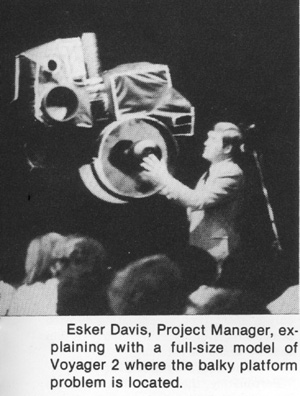 As a consequence: "We have only one high resolution Enceladus mosaic instead of three. One of 2 high resolution mosaics of Tethys. . . "
As a consequence: "We have only one high resolution Enceladus mosaic instead of three. One of 2 high resolution mosaics of Tethys. . . "
Despite the very regrettable loss of some information which we probably will not be able to obtain again in our lifetime, Voyager 2 sent us a tremendous volume of data, some supporting earlier hypotheses, some contradicting them, and all adding to our knowledge of Saturn and the solar system. There is only room here for three examples:
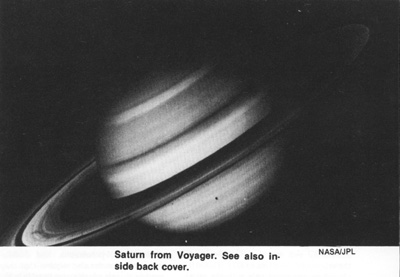 Using the spacecraft's radio to determine particle sizes as the signal passed through the rings, analysts concluded that the average size of particle in the A-Ring is 10 meters, in the outer part of the Cassini Division 8 meters, and in the C-Ring 2 meters.
Using the spacecraft's radio to determine particle sizes as the signal passed through the rings, analysts concluded that the average size of particle in the A-Ring is 10 meters, in the outer part of the Cassini Division 8 meters, and in the C-Ring 2 meters.
Although Voyager 2 gave much attention to the spoke-like structures in the B-Ring, they continue to defy explanation. One theory proposed that the spokes are electrostatically levitated particles of fine dust, lifted above the plane of the rest of the B-Ring by Saturn's magnetic field, but the three pictures taken during ring plane crossing showed no evidence of particle levitation.
Phoebe, the outermost satellite of Saturn, is about 190 kilometers in diameter, twice as large as previously measured from earth, and is probably a captured asteroid.
[Photo below is from the inside back cover of the magazine.]
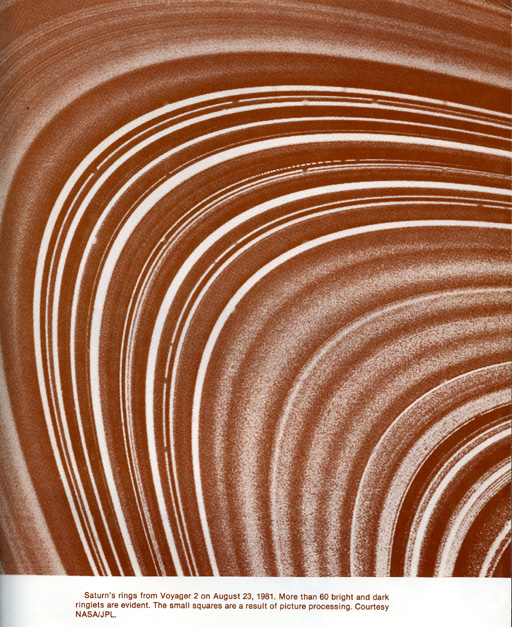
Every day a wealth of such reports poured forth from JPL's Public Information Office. To get a preliminary assessment of the relative importance of the findings I asked David Morrison of the imaging teams what he thought were Voyager 2's most important Saturn discoveries. He replied:
"Two clearly are at the top of the list. One is the degree of fine structure and dynamism in the rings. I think the most spectacular single picture from Voyager 2 is the one in which you try to line up the two parts of the B-Ring and find that they do match in fine scale structure. Just the existence of structure down to the kilometer and sub-kilometer level is fascinating. The fact that it is clearly wave motion, that when you're looking at the rings you're not looking at a static structure but at something that's more like the waves on the surface of an ocean, I think is the main thing. We did not get that close a look with Voyager One at the rings. So that is new.
The second major discovery is Enceladus. To have discovered a small satellite which has no right to be geologically active, to discover that it IS geologically active, that it has youthful surface, is completely unexpected, and leaves us with essentially having to explain the existence of some heat engine inside Enceladus, which we had no reason to anticipate.
Those are clearly the top finds. Then there are some other things, perhaps more interactive with Voyager One. The discovery that the outer edge of the B-Ring is an ellipse with Saturn at the center instead of at one focus, and the kind of orbital resonances which produce that, was quite unexpected.
The fact that we did not find the embedded moons, that we thought were causing gaps was unexpected. The fact that we found no new satellites at all is sort of surprising. The fact that we found kinks in the ringlets inside the Keeler Division but did not find kinks or braids in the F Ring this time is certainly confusing.
Clearly the fact that the camera was taking better pictures of Saturn this time and the atmosphere was more active provides a wealth of new data for the atmospheric dynamicists, a lot more than Voyager One did.
Hour after hour, day after day, pictures of the distant planet, its rings and its satellites were on the closed circuit television monitors in the offices, laboratories, auditorium and cafeteria at JPL. The mood of the watchers was a mixture of joy and sadness, of elation and concern: elation over the success of the Voyager encounters with Jupiter and Saturn, but sadness that this might be the last planetary encounter for a long while, perhaps for our lifetimes.
Along with questions raised by the intriguing information pouring in from Saturn, there were also questions about the future of the space program in general. When will other spacecraft be launched, craft which take years to plan and build, and still further years to travel through interplanetary space? What about more traditional activities, such as ground based astronomy? What about projects whose support is precarious even during more favorable times, projects such as the search for extraterrestrial intelligence?
And what about the Voyagers themselves?
The Voyagers will continue their virtually endless journeys out of the solar system, and Voyager 2 could send us information about Uranus and Neptune. But will there be a scientific team at JPL in 1986 and 1989 to receive and analyze the data?
It would indeed be ironic if this craft, built to journey through interplanetary space for a million years, carrying information about Earth to the still unknown civilizations around distant stars, is forgotten by us, its makers, even before it leaves our own solar system.
 David W. Swift covered the voyager 2-Saturn encounter at JPL for COSMIC SEARCH. A PH. D. from the University of California at Berkeley, Dr. Swift is Professor of Sociology at the University of Hawaii and a Contributing Editor of COSMIC SEARCH.
David W. Swift covered the voyager 2-Saturn encounter at JPL for COSMIC SEARCH. A PH. D. from the University of California at Berkeley, Dr. Swift is Professor of Sociology at the University of Hawaii and a Contributing Editor of COSMIC SEARCH.
|
|
When to Look Where
By: Clifford E. Singer
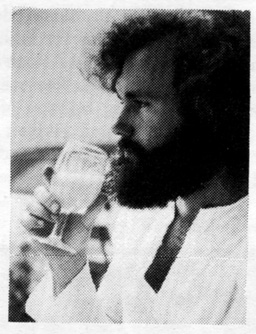 In a search it is important to know where to look (see Frank Drake in COSMIC SEARCH no. 12, page 7) and also on what channel (see the Waterhole in COSMIC SEARCH no. 2, page 39). It is also important to know when to look. Dr. Singer addresses this problem.
In a search it is important to know where to look (see Frank Drake in COSMIC SEARCH no. 12, page 7) and also on what channel (see the Waterhole in COSMIC SEARCH no. 2, page 39). It is also important to know when to look. Dr. Singer addresses this problem.
The next round of searches for ExtraTerrestrial Intelligence (ETI) will use two strategies. One strategy is to search small areas of the sky in the galactic plane in the hopes that one area will contain a strong source. This strategy is called the survey mode. The other strategy is called the serial search mode in which nearby stars are examined serially, that is, one by one.
The serial search mode is more interesting to exobiologists because the search must be guided by our knowledge of astronomy and our speculations about the origin and evolution of ETI. This article will be concerned only with the serial search mode assuming for the sake of argument that a serial search is a good idea, and asking only if present plans give the best way to conduct the search.
Any search for signals from ETI faces two major problems. The first problem is how to select the search targets. The second problem is how to search each target. The second problem is discussed in an extensive literature, the proposed solution being to use common astrophysical knowledge which allows us and ETI to guess at a set of preferred frequencies to broadcast and attempt to receive. On the other hand, the only astrophysical knowledge used so far to guide the order in which targets are searched is the spectral type and luminosity of each star. The strategy has been simply to search the nearest likely targets first.* (* The probability of success of serial search is discussed by the author in the Journal of the British Interplanetary Society (in press) 1981.)
The problem with this simple method of ordering the search targets is that it overlooks another important piece of astrophysical knowledge which should be common to both us and ETI. This common piece of knowledge is the motion of the sun as it wanders across the transmitter's sky. We shall see that this common knowledge can be used to define a preferred set of times to listen to each star and, thereby, increase the probability of success in a serial search by many orders-of-magnitude. Before going into more detail, we need to review the assumptions which are being used to guide serial searches over the next one or two decades.
SETI Scenario
From our point of view, an aggressive serial search involves looking at up to a million of the best candidates among stars up to as much as 1,000 light years from the Sun. This could require several decades of observing time on large radio telescopes. Success requires that at least one ETI in the search volume broadcasts to us at one of our favorite combinations of frequency, polarization, and modulation mode. Success also requires that they send us signals which arrive exactly in the relatively short interval we devote to them in our search.
Now consider the problem from the point of view of the ETI which transmits to us. (For simplicity, we temporarily assume they are the only ETI in the sphere of radius 1,000 light years which defines our search volume.) We are assuming they are going to send us a signal which we detect in our first aggressive search. Unless they know exactly when we start looking at them, this means they must broadcast to us continually over a galactic evolution timescale, on the order of a billion years. But following the evolution of our pretechnological civilization and predicting its maturity up to 2,000 years in the future from a distance of 1,000 light years is a formidable problem. No solution short of sending an interstellar probe has been proposed, and, if this solution were available, the ETI could easily use the probe as a beacon instead of transmitting across interstellar distances. The ETI source also faces the problem of transmitting to all other potential receivers within 1,000 light years, also during a galactic timespan. If some way could be found to reduce this formidable broadcasting load, then the total power requirement could be dramatically reduced, or the strength or information content of the signal could be increased.
Part of the solution to reduce transmission requirements is to broadcast a narrow beam to each potential receiver. This requires only that ETI maintain a modest astrometry program so that they know where each target will be when the signal arrives. Narrow beam transmission has the great advantage that it can reduce the power transmission required by orders-of-magnitude at the cost of a very modest improvement in the quality of the transmitter.
This still leaves the ETI source with the problem of broadcasting continually to all potential receivers over a galactic evolution timescale. This conclusion is not altered if one makes the more common assumption that there were a large number of ETI in our search volume but they each broadcast for only a fraction of a billion years. Evidently, there is much to be gained in terms of power requirements or signal quality if the ETI could spend only a short time broadcasting to each possible receiver and still be fairly certain that we would be listening.
The Sun's Proper Motion
Fortunately, there is a clock which we can use to define preferred times to listen to stars in a given direction. The orbital motion of the planets around the Sun produces periodic slight displacements in the Sun's position as viewed from the distant stars. The change in position of a star in the sky, including these slight displacements, is called proper motion.
Remembering that the ETI we detect must keep broadcasting over a galactic timescale, it is easy to see how they could measure the Sun's proper motion to this accuracy. Such a measurement requires a good optical interferometer or the equivalent. There are at present serious proposals to build such an instrument in Earth orbit. This instrument would have a resolution of around one microarcsecond, which is probably limited by thermal expansion in the connection of the relatively modest baseline of ten meters. Now the maximum displacement of the Sun due to Jupiter's orbital motion is about 1 percent of the distance from the Sun to the Earth. For ETI to determine this displacement to an accuracy of one part in 100,000 from 1,000 light years away would require about ten measurements with a resolution of one nanoarcsecond. There is every reason to believe that the step from microarcsecond resolution instruments now being proposed to nanoarcsecond resolution would not be a major requirement for a mature technological civilization. The required ten kilometer baseline could probably be achieved by shielding the instrument from stellar heating and/or by careful laser ranging between the photon collectors. Alternately, more patient ETI could use an instrument with lower resolution and average data taken over a longer interval.
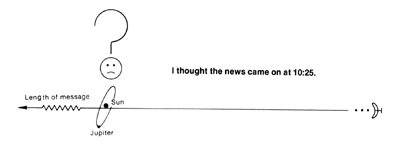 In addition to making an accurate measurement of the Sun's proper motion across their sky so we can "synchronize our watches," the ETI must also know the distance to the Sun with comparable accuracy. Otherwise, their signals will not arrive at the preferred times. For example, if they underestimate the distance to the Sun by 0.1 light years and transmit to us only for a day every five years, then we may tune in a month after their signal passes through the solar system. (see sketch). Fortunately, the instrument they use to measure the Sun's proper motion can also find the distance to the Sun, by parallax. For example, if the instrument has an orbit around its star with a diameter 3 times that of the Earth around the Sun, then with nanoarcsecond resolution it could measure a 1,000 light-year distance to the Sun to within 1/10,000 light-year in one set of measurements. This accuracy would allow ETI to time their transmissions to arrive within 1/100,000 Jovian orbital periods of the preferred times for us to receive them.
In addition to making an accurate measurement of the Sun's proper motion across their sky so we can "synchronize our watches," the ETI must also know the distance to the Sun with comparable accuracy. Otherwise, their signals will not arrive at the preferred times. For example, if they underestimate the distance to the Sun by 0.1 light years and transmit to us only for a day every five years, then we may tune in a month after their signal passes through the solar system. (see sketch). Fortunately, the instrument they use to measure the Sun's proper motion can also find the distance to the Sun, by parallax. For example, if the instrument has an orbit around its star with a diameter 3 times that of the Earth around the Sun, then with nanoarcsecond resolution it could measure a 1,000 light-year distance to the Sun to within 1/10,000 light-year in one set of measurements. This accuracy would allow ETI to time their transmissions to arrive within 1/100,000 Jovian orbital periods of the preferred times for us to receive them.
In principle then, the orbital displacement of the Sun during its proper motion across the transmitter's sky defines a preferred time for ETI to send signals to us. In practice, there may be some ambiguity due to the minor influence of Saturn and other planets superimposed on the dominant ten year period defined by Jupiter. There is also the question of whether to listen at times of maximum displacement, or whether to prefer minimum displacement (i.e., conjunctions of Jupiter with the Sun as viewed from the search target). As with frequency selection, the solution to this ambiguity must be to define a set of preferred search times and to devote the most observing time to those that seem most likely. Since the frequency spectrum of the Sun's displacement from its mean proper motion has only a few prominent peaks and valleys, this ambiguity should not decrease the usefulness of the synchronization technique by even an order of magnitude. And if some ETI adopt a strategy of broadcasting at a few preferred times rather than a single preferred time, the chances of having overlapping timing strategies rapidly approaches unity.
Another potential ambiguity in guessing common broadcast timing strategies is the possible use of other mutual observables. An example would be using supernovae explosions as a timing synchronizer. However, such strategies require us as well ETI to make an extremely accurate distance measurement, for reasons similar to those discussed above. It should be clear that this is likely to be beyond the capability of the most recently emerging listeners. Perhaps such possibilities should be investigated further, but for the moment the regular motion of solar planets is the only method for accurate synchronization known to be available to us and to potential sources of communication from extraterrestrial intelligence.
The advantage of having such a synchronization method is quite clear. The advantage is directly analogous to that of transmitting at preferred frequencies. In the case of frequency selection, ETI have the choice of using a large number of transmitters or enormous power to transmit at all frequencies, or they can effect a large reduction in transmission requirements using preferred frequencies defined by common astrophysical knowledge. In the case of broadcast timing, ETI have the choice of transmitting simultaneously to all possible listeners, or they can build a single interferometer to acquire the common astrophysical knowledge which allows broadcasting to all potential listeners at preferred times with a single transmitter of modest power.
Conclusion
The merits of adopting the search strategy proposed here have been clearly outlined above — an increase by four or five orders-of-magnitude in the probability of discovering an ETI would be worth a great deal in terms of observing time. Moreover, it is not necessary to make the dangerous assumption that all ETI will assume the broadcast strategy proposed here. Even if only a few ETI adopt a synchronized broadcast strategy, they will still have orders-of-magnitude advantage in broadcast power or bandwidth and therefore be the easiest to detect if the appropriate search strategy is chosen. It only remains to make two closing comments about implementing this proposal.
First, despite a thirty year history as a modern discipline, the field called "interstellar studies" has the equivalent of only a handful of full time workers. The discipline is therefore still in the early stages of development, and it may well be that some essential ideas have been overlooked. A search strategy synchronized with the Sun's motion is an example of such an idea.
The final comment, and the most compelling reason that a synchronized search strategy should be adopted if one wishes to maximize the chance of detecting communication from extraterrestrial intelligence, is very simple. If one intends to observe a large number of stars, then it hardly matters in what order the stars are searched. Reordering the observing targets to look at certain stars at preferred times is a minor inconvenience. It therefore seems obvious to take at least half of the observing time devoted to serial searching and attempt to gain the orders-of-magnitude improvement which should result from the synchronized search strategy.

 Clifford E. Singer received his Ph.D. in Biochemistry from the University of California at Berkeley in 1971 and now works on controlled fusion at Princeton. Dr. Singer has published research papers on molecular biology, genetic evolution, solar and lunar physics, plasma physics, extraterrestrial resources, and interstellar propulsion and extraterrestrial intelligence. This article is the third in a series called "Galactic Extraterrestrial Intelligence". The first article in this series will appear this year in the Journal of the British Interplanetary Society.
Clifford E. Singer received his Ph.D. in Biochemistry from the University of California at Berkeley in 1971 and now works on controlled fusion at Princeton. Dr. Singer has published research papers on molecular biology, genetic evolution, solar and lunar physics, plasma physics, extraterrestrial resources, and interstellar propulsion and extraterrestrial intelligence. This article is the third in a series called "Galactic Extraterrestrial Intelligence". The first article in this series will appear this year in the Journal of the British Interplanetary Society.
|
|
ABCs of Space
By: John Kraus
The Satellite Revolution
NASA holds the key to our future more than any other federal agency. What NASA plans now and can subsequently accomplish will determine where the U.S. will be 10, 20, 50 and 100 years from now, not just in space but with respect to our entire economy.
•
The ultimate goal of astrophysics is to understand the origin and evolution of the universe.
When Columbus and other early navigators set out on their voyages of discovery across the oceans, they launched a global diffusion of European culture with an attendant increase in our knowledge of the world and utilization of its resources. Now 500 years later, we have a parallel. Space is a vast ocean and our satellites, probes and astronauts moving out into it can launch a humanization of space with an attendant increase in our knowledge of the universe and utilization of its resources.
Sputnik catapulted the world into the Space Age with the first artificial satellite. The earth is now surrounded with thousands of them, like a swarm of bees, most in low orbit circling the Earth in as little as 90 minutes but with others in higher, slower orbits, particularly the Clarke or geostationary orbit where a satellite remains poised above a fixed point on the Earth's equator.
When Arthur C. Clarke proposed the geostationary satellite as a solution to the world's communication problems a dozen years before Sputnik, many regarded his idea as visionary and far-fetched. But today communication satellites in the Clarke orbit are a multi-billion dollar business providing services for millions, employment for thousands and stock dividends for thousands more. These satellites carry an increasing fraction of the world's telephone, TV and civilian and military messages. For example, today's national and international businesses operate more efficiently by linking all intercenter voice, data, graphics and video traffic for all their scattered offices and factories via Clarke satellite while entire newspapers are relayed for simultaneous publication in distant cities by Clarke satellite. The list of other applications is long and growing.
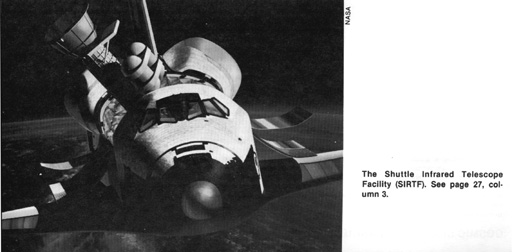 The role of the Space Shuttle in expanding our activites in space is crucial. It has opened a new era of space utilization, facilitating the deployment of satellites of all kinds, making them less expensive and permitting their maintenance in space and/or their return to Earth for modification and refurbishing.
The role of the Space Shuttle in expanding our activites in space is crucial. It has opened a new era of space utilization, facilitating the deployment of satellites of all kinds, making them less expensive and permitting their maintenance in space and/or their return to Earth for modification and refurbishing.
Columbus and other early navigators used the stars and magnetic compass to find their way. Modern space craft rely on our increased knowledge of the heavens and on sophisticated electronic technology for guidance.
Our future is tied to space and its utilization. The National Aeronautics and Space Administration (NASA) holds the key to this future more than any other federal agency. What NASA plans now and can subsequently accomplish will determine where America will be 10, 20, 50 and 100 years from now, not just in space but with respect to our entire economy. We are part of space and space is part of us.
NASA has recently formulated a number of imaginative, exciting, yet practical, plans for future space instruments that can revolutionize our knowledge of the universe and our ability to utilize its resources. In this article I describe some of these astronomical instruments with a few brief comments. But to put these devices of the future in perspective, let me review some of the instruments NASA has already put into space and ones now being readied for orbit in the next few years.
It must be kept in mind that putting a complex instrument into space is not an overnight affair; it takes years of planning and more years of actual construction before a satellite is ready to go up. From initial plans to orbit can easily take 10 years or more.
Early NASA space instruments were designed to explore regions of the electromagnetic spectrum (see illustration above) which can't be observed from the Earth's surface because the waves are so short they are blocked by the Earth's atmosphere or so long they are cut off by the Earth's ionosphere. Thus, at the short end, studies of gamma rays, x-rays and the shorter ultra-violet rays require instruments in orbit above the Earth's atmosphere. Although some early x-ray observations were made from rockets rising above the Earth's atmosphere for a few moments, these provided only fleeting, tantalizing glimpses. At the long wavelength end, studies of kilometer radio waves also require instruments above and beyond the Earth's ionosphere.
Thus, one of the first NASA space observatories was an x-ray satellite on which planning began actively in 1963. Seven years later this satellite, called UHURU, was launched from Africa. This was followed by more advanced x-ray satellites including the High Energy Astronomical Observatory-1 (HEAO-1) launched in 1977 and HEAO-2, called Einstein, launched in 1978.
In the mid-1960s the U.S. orbited several satellites, code-named Vela, to monitor the Nuclear Test Ban Treaty by means of gamma-ray detectors. These detectors have recorded a number of short intense bursts of gamma rays characteristic in many ways of nuclear explosions in space. They appeared to have come from somewhere beyond the solar system but their cause and origin are not known.
Subsequently, a number of gamma-ray satellites were orbited by NASA including SAS-2 in 1972, COS-2 and SAS-3 in 1975 and HEAO-3 in September 1979. On March 5, 1979, a number of U.S. and Soviet satellites detected an intense gamma-ray burst that seemed to come from the Large Magellanic cloud at a distance of 160,000 light-years, thus localizing the direction of at least one of the bursts.
For the shorter ultra-violet wavelengths NASA put up the orbiting Astronomical Observatory-2 (OAO-2) in 1968 and the Copernicus Satellite (OAO-3) in 1972. The International Ultra-violet Explorer (IUE-A) was a joint U.S.-European venture launched in 1978.
For the long radio wavelengths NASA orbited the Radio Astronomy Explorer-A (RAE-A or Explorer 38) in 1968 and in 1973 RAE-2 was orbited, not around the earth but around the moon in order to take advantage of the Moon's shielding to reduce interference from radiations from the Earth and Sun at wavelengths of 100 to several 1000 meters. The terrestrial interference for which shielding was needed did not come from manmade transmitters but rather from a natural radiation from the Van Allen particle belts above the Earth's ionosphere. At times the power of this radiation reaches power levels of one gigawatt (one million kilowatts).
Our society is now at a unique juncture where:
(1) sensitive instruments have been developed for observing all across the electromagnetic spectrum from the shortest gamma rays to the longest radio waves;
(2) space flight has been achieved so that these instruments can be orbited above the Earth's atmosphere where essentially the full electromagnetic spectrum can be observed; the Space Shuttle is an important step in this development;
(3) microwave technology has been developed to the point where satellites and probes can be remotely controlled by radio links and pictures and observational data telemetered to Earth control centers;
(4) computer technology has been developed that permits the storage, processing and enhancement of the vast amounts of data acquired.
We are at a point in time where these technological developments can be applied to produce further rapid advancements in our knowledge and utilization of space and the universe. Many important new discoveries may be in the offing.
Astronomical space exploration follows a logical sequence:
(1) Surveys to map the sky and pinpoint objects.
(2) Studies of individual objects discovered in the surveys.
(3) More detailed and extensive studies of individual objects with specialized instruments and techniques.
This sequence will be noted in the missions accomplished to date and planned for the future.
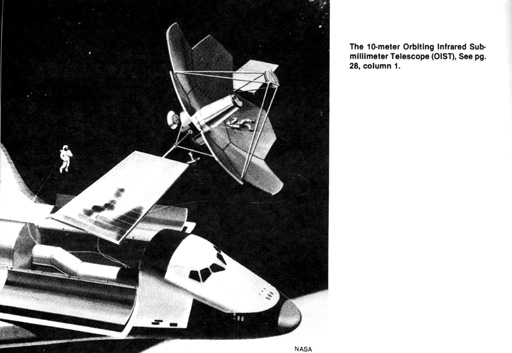 In cooperation with the Space Science Board of the National Academy of Sciences, with other groups and with individual scientists, a number of projects have been planned by NASA to take advantage of the new opportunities space offers.
In cooperation with the Space Science Board of the National Academy of Sciences, with other groups and with individual scientists, a number of projects have been planned by NASA to take advantage of the new opportunities space offers.
Not all of the following satellites and instruments planned for the future will be flown since development is in a constant state of evolution. What is being learned is continually being applied to improve and refine later instruments and observations. Funding must also be authorized to complete plans and to construct and orbit the instruments.
With the 2 historic flights of the Space Shuttle Columbia April 12-14, 1981, and the record flight Nov. 12-14, 1981, the U.S. has in initiated a new era of greatly increased capability which is essential for our continued exploration and ultimate utilization of space. NASA's future plans are dependent on frequent flights by the Space Shuttles.
[Note. The following table shows a reorganization of the list and related illustrations of satellites and instruments from that shown in the magazine article.]
| ST |
The Space Telescope with 2.4 meter mirror for optical and ultra-violet observations will be one of the Space Shuttle's first launching assignments. Above the Earth's atmosphere the new telescope will afford astronomers a vastly improved view of the cosmos. |
|
| GRO |
The Gamma Ray Observatory will study the full range of gamma ray phenomena over the whole sky at high sensitivity and resolution. It will carry a burst detector, a high resolution spectrometer, a broad band spectrometer, a double Compton telescope and a high energy telescope.
| 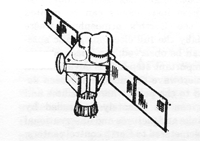 |
| GTE | The Gamma-ray Transient Explorer will study gamma-ray pulses (discovered by the Vela satellites) with an all-sky coverage, gamma-ray bursts from the Sun and electron-positron pair annihilation radiation from space.
| |
| AXAF | The Advanced X-ray Astrophysics Observatory is an X-ray satellite for studying structure and composition of stars, quasars, pulsars and black holes and also for studying the elements in space.
| 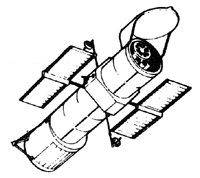 |
| XTE | The X-ray Timing Explorer will study the rapidly pulsing x-ray emitting objects. |
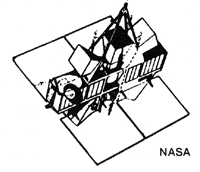 |
| XRO | The X-ray Observatory is planned for continuing and extending studies of earlier x-ray satellites. |
 |
| LAMAR | The Large Area Modular Array of Reflectors is planned for mapping the x-ray sky at high sensitivity, 1 arc minute resolution and 1 degree field of view. |
|
| SXE | The Soft X-ray Explorer is for studying soft (or long wavelength) x-rays in the 1 to 10 nanometer range.
| |
| EUVE | The Extreme Ultra-Violet Explorer will conduct an all-sky survey at short ultra-violet wavelengths (10 to 100 nanometers) for the detection of stars within about 300 light-years to provide new information about the local star population, star evolution and star dynamics.
| |
| FUSE | The Far Ultra-violet Spectroscopy Explorers are to make spectral analyses of distant stars, galaxies and interstellar matter in the 90 to 120 nanometer wavelength range. Quintuply ionized oxygen (OVI) has a fundamental line at 103 nanometers which is a unique tracer of hot gas.
| 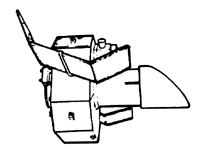 |
| EUVSE | The Extreme Ultra-Violet Spectroscopy Explorer is to perform spectral analysis of specific celestial objects in the 7 to 100 nanometer wavelength range, including white dwarf stars, flare stars, and highly variable stars.
| |
| SAE | The Simultaneous Astronomical Explorer will monitor and study variable phenomena at ultra-violet and optical wavelengths from 4 to 900 nanometers. Of particular interest are flare stars, quasars, BL Lacertae objects, and Seyfert galaxies.
| |
| Star Lab | For investigations of space within the solar system, our galaxy and between galaxies at ultra-violet, optical and infra-red wavelengths a 1-meter diameter telescope will be mounted in the cargo bay of the Space Shuttle.
| 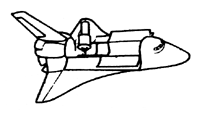 |
| VLST | The Very Large Space Telescope is to be of 6 to 10 meters diameter for ultra-violet, optical and infra-red observations of distant objects to help establish such things as the characteristics and dynamics of galaxy clusters (as the one in Virgo) and to extend Hubble's redshift measurements to more distant galaxies. The components for this telescope would be brought up by the Space Shuttle for assembly in orbit.
| 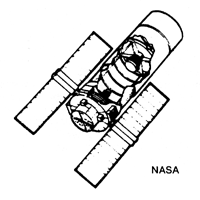 |
| TAT | The 100 meter Thinned Aperture Telescope. This telescope, of 100 meter diameter, would consist of a narrow ring-like reflector made up of an array of individual mirror elements automatically kept in position and alignment. The telescope would provide the high resolution and sensititivy at ultra-violet, optical and infra-red wavelengths needed to detect planetary systems around other stars. Such a discovery would be a momentous event. Whereas the Space Telescope has the potential of discovering Jupiter sized planets associated with other stars, TAT could detect considerably smaller planets.
| 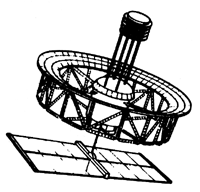 |
| COSMIC | The Coherent Optical System of Modular Imaging Collectors is to provide the increased sensitivity and resolution needed to extend productive optical research programs into the 1990s and beyond. Plans under consideration involve high-resolution optical interferometers.
| 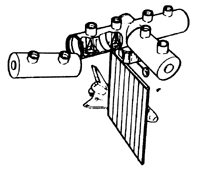 |
| MLSE | The Molecular Line Survey Explorer will study the evolution of stars through the emission of their molecules at long infra-red wavelengths (0.1 to 1 millimeters). There are about 50 known kinds of molecules that have been found in giant gas clouds of our galaxy.
| |
| SIRTF | The Shuttle Infra-Red Telescope Facility is to provide a million-fold improvement over present ground-based telescopes at 2 to 200 micro-meter wavelengths. This is needed to follow up on sources discovered in infra-red surveys now being completed. An 85-centimeter telescope cooled to about 20K (or 20 degrees Celsius above absolute zero) would be mounted in the cargo bay of the Space Shuttle. Observations should provide new insights into star and galaxy formation, and may lead to the discovery of previously undetected red dwarf stars which may constitute some of the missing mass of our galaxy.
| |
| COBE | The Cosmic Background Explorer is planned for an infra-red-radio survey of the sky between 1 micrometer and 13 millimeter wavelength to determine the spectrum of the 3 degree cosmic background (primordial fireball) radiation and to look for any irregularities in its angular distribution. The satellite orbit will be so oriented that the Sun will always be to one side and the Earth always below the observing direction to help prevent solar and terrestrial radiation from reaching the measuring instruments which will be kept refrigerated at a temperature close to absolute zero.
| |
| OIST | The Orbiting Infra-red Submillimeter Telescope will study the 3 degree cosmic background radiation, the evolution of gas clouds into stars, the properties of dust grains in space and the formation of quasars. Plans contemplate a 10 meter diameter deployable reflecting telescope for operation at 30 micrometer and longer wavelengths with resolution of about 10 arc seconds.
| |
| LADIT | The Large Ambient Deployable Infra-red Telescope is for studying stars, quasars, galactic structure and galaxy evolution. A telescope of 10 meter diameter or more operating at 30 to 1000 micrometer wavelengths is contemplated.
| |
| IRIS | The Infra-Red Interferometer in Space is to provide increased resolution at infra-red wavelengths by using 3 SIRTF-type telescopes mounted on a 100 meter platform as one possibility.
| |
| VLSI | The Orbiting Very Long Baseline Interferometry Observatory involves plans which contemplate a 30 to 60 meter diameter parabolic dish antenna in orbit to operate in conjunction with earth-based radio telescopes for providing more baseline combinations (in separation and orientation) than is possible with present entirely earth-based telescopes. Operation would be at 1 to 30 centimeter wavelengths. Earth-based radio interferometers with intercontinental base lines have produced radio pictures of celestial objects at resolutions almost a thousand times better than can be achieved photographically with the largest optical telescopes. The addition of an orbiting radio telescope would make it possible to produce significantly improved radio pictures.
| |
| HNE | The Heavy Nuclei Explorer is to study the origin and path of travel of cosmic ray particles to give insights regarding the formation of atomic nucleii. Heavy, high-energy particles are best for such studies because they are deflected least by magnetic fields.
| |
| CRO | The Cosmic Ray Observatory is for studying the origin, acceleration and propagation of cosmic ray particles which permeate space like a gas. The particles constitute a sample of matter from outside the solar system and consist of many nuclei that range over the entire periodic table. Particle telescopes in CRO will look for particular elements.
Cosmic rays consist of particles (such as protons) as distinguished from electromagnetic radiation or waves (also sometimes called rays, as for example, x-rays). The Earth's atmosphere impedes the passage of these particles to the Earth's surface so cosmic ray observations have in the past been done from high altitude balloons. In space above the atmosphere their detection and study will be facilitated. Many of the particles are atomic nuclei that are believed to have originated in distant, ancient stellar explosions or other violent events.
| |
| LIST OF ASTRONOMICAL SATELLITES AND KEY TO ABBREVIATIONS |
AIE: Advanced Interplanetary Explorer
Ariel: United Kingdom-5, X-ray and ultra-violet
AXAF: Advanced X-ray Astrophysics Facility
BDCE: Beta Decay Clock Experiment
COBE: Cosmic Background Explorer (infra-red)
Copernicus: Orbiting Astronomical Observatory-3
COS: COsmic ray Satellite
COSMIC: Coherent Optical System of Modular Imaging Collectors
CRO: Cosmic Ray Observatory
Einstein (HEAO-2): High Energy Astronomical Observatory-2 (HEAO-2) (X-ray)
EUVE: Extreme Ultra-Violet Explorer
EUVSE: Extreme Ultra-Violet Spectroscopy Explorer
Explorer 37: x-ray
FUSE: Far Ultra-violet Spectroscopy Explorer
GP-A: Gravity Probe-A
GP-B: Gravity Probe-B
GTE: Gamma-ray Transient Explorer
GRO: Gamma-Ray Observatory
HEAO: High Energy Astronomical Observatory
HMRE: Hydrogen Maser Redshift Experiment for test of Einstein theory
HNE: Heavy Nuclei Explorer
IRAS: Infra-Red Astronomy Satellite (1982)
IRIS: Infra-Red Interferometer in Space
IUE-A: International Ultra-violet Explorer
LADIT: Large Ambient Deployable Infra-red Telescope
LAMAR: Large Area Modular Array of Reflectors (x-ray)
MLSE: Molecular Line Survey Explorer
OAO: Orbiting Astronomical Observatory. Ultra-violet
OIST: Orbiting Infra-red Submillimeter Telescope
OSO: Orbiting Solar Observatory
OST: Orbiting Submillimeter Telescope
RAE-A: Radio Astronomy Explorer-A. (Explorer 38)
RAE-B: Radio Astronomy Explorer-B. Lunar orbit
SAE: Simultaneous Astronomical Explorer
SIRTF: Shuttle Infra-Red Telescope Facility
Star Lab: 1-meter telescope on Space Shuttle for optical, ultra-violet and infra-red
ST: Space Telescope (Ultra-violet and optical)
SXE: Soft X-ray Explorer
Syncom-2: Synchonous communications satellite
TAT: Thinned Aperture Telescope of 100-meter diameter
UHURU: X-ray Observatory
Vela: Gamma-ray Observatory
VLBI: Orbiting Very Long Baseline Interferometer (radio)
VLST: Very Large Space Telescope
VOIR: Venus Orbiting Imaging Radar
XRO: X-Ray Observatory
XSE: X-ray Spectroscopy Explorer
XTE: X-ray Timing Explorer
|

|
|
The Cosmic Quest
By: H. James Birx and Gary R. Clark
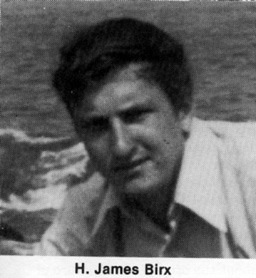
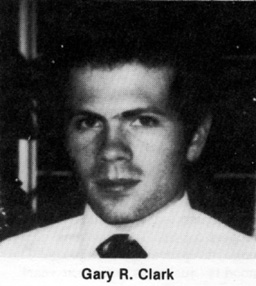 Our earth is nearly five billion years old, and life emerged on this planet approximately four billion years ago. The transition from geogenesis to biogenesis was a major advance. With the recent origin of the human species, the evolution process has become aware of itself. Yet, is there life or intelligence on other earthlike planets throughout the universe?
Our earth is nearly five billion years old, and life emerged on this planet approximately four billion years ago. The transition from geogenesis to biogenesis was a major advance. With the recent origin of the human species, the evolution process has become aware of itself. Yet, is there life or intelligence on other earthlike planets throughout the universe?
No doubt prehistoric men gazed at the night skies, curious about those distant shining objects strewn across the ominous heavens. In their lack of scientific understanding and fear of the unknown, they resorted to magicoreligious thought and activities as well as legends and myths to explain a world seemingly inhabited by both good and evil spirits.
In antiquity, some natural philosophers not only advocated the empirical/rational investigation of nature but also speculated on living things elsewhere in the cosmos, e.g., Xenophanes, Epicurus, and Lucretius. The following church-dominated dark ages and medieval period suppressed scientific inquiry. Turning from nature to the supernatural, Augustine wrote that he could no longer dream about the stars. Later, however, Nicholas of Cusa did envision inhabitants in every region of the universe.
During the subsequent renaissance, Giordano Bruno (1548-1600) boldly initiated the modern cosmology: an orientation revitalized by Carl Sagan in this century.
Bruno went far beyond the Aristarchus/Copernicus heliocentric theory by claiming the universe to be eternal in time, infinite in space, and endlessly changing. His own sweeping world-view is grounded in the metaphysical principles of plurality, uniformity, and cosmic unity. He rejected the peripatetic terrestrial/celestial dichotomy in favor of an infinite number of inhabited worlds more or less analogous to our earth: life and intelligence necessarily exist throughout the infinite universe.
Bruno overcame all geocentric, zoo-centric and anthropocentric models of reality. Likewise, the theme of extraterrestrial life or intelligence was later also supported by: Kepler, Wilkins, Huygens, Fontenelle, Kant, Haeckel, Lowell, and Hoyle.
In the last century, the rigorous search for fossils led to discovering those unusual lifeforms of the remote past. The Lamarck/Darwin evolution framework held the human animal to be a recent product of organic history. Yet, how accidental or inevitable is biological evolution? Although lifeforms did emerge at least once in this noisy and violent universe, exobiologists speculate that they will be found elsewhere (perhaps based on different chemistries other than carbon, e.g., silicon or ammonia). Thus, man's intellectual penetration into the infinity of cosmic space was followed by an equally important intellectual penetration into the depths of evolutionary time.
Logic does not dictate that man or the earth must be unique. The birth of stars may inevitably entail the formation of planets engaged in prebiotic chemistry producing organic molecules like nucleotides and/or amino acids (hydrogen, liquid water, and energy are abundant throughout the cosmos). If the basic laws of biology and physics are applicable throughout the universe, then the emergence of life from matter seems inevitable given the environmental prerequisites.
To date, the life sciences have restricted their concerns to the earth. However, humankind is no longer confined either intellectually or physically to the finite sphericity of this globe. The new challenge is to overcome the myopic planetary view of things by adopting a properly contextual cosmic perspective of reality. Although there is at present no irrefutable empirical evidence for astrobiology or sentient life beyond our planet, this alone should not deter the cosmic quest: it is too soon to abandon exobiology. No dogmatic closure should be placed on human wonder or free inquiry in an open society.
Fortunately, there are those who are still eager to seriously pursue a rigorous search for organisms and civilizations elsewhere among innumerable galaxies. Unmanned interplanetary and interstellar vehicle probes as well as radio telescopes penetrate the abysses of outer space in order to detect empirical evidence of extraterrestrial life or intelligence. Further advances in space technology incorporating extraplanetary telescopes and minicomputers will greatly enhance the human search for protoplasmic existence and intelligence on other celestial bodies throughout the universe.
Apparently the moons and other planets of our own solar system do not support indigenous living things. However, astrobiology maintains that this physical universe may be a zoocosmos teaming with life. Beyond our Milky Way are billions of other galaxies, each with billions of stars if not also countless sun/planet systems. A myriad of other worlds may be swarming with awesome biological forms, disquieting alien beings, and perhaps even organic phenomena beyond man's present cognition. Thus, although as a form of highly organized matter life may be a relatively rare occurence in each galaxy, it is statistically speaking still bound to be very abundant in the cosmos as a whole in view of the staggering number of the galaxies.
Special stony carbonaceous chondrite meteorites contain water, minerals, and complex organic molecules as hydrocarbons or amino acids (the precursors of life on earth). Comets, asteriods, and cosmic gas/dust clouds do harbor these molecules of prebiotic chemistry which anticipate organic phenomena. Physical uniformity or the seemingly pervasive and inexorable laws of nature, statistical probability, empirical inferences, and a temporal framework of billions of years all support both the logical possiblity and empirical probability of life-yielding star/planet systems throughout the universe.
Even if the event is centuries from now, the anticipated conclusive empirical evidence for extraplanetary life or human contact with extraterrestrial intelligence will be the most profound discovery in the history of scientific inquiry and a singularly awesome turning-point in the life of our species. This event will stimulate a retrospective reevaluation of the nature of existence and at the same time revolutionize our conception of the meaning and destiny of humankind. In fact, the distant descendants of our species may enjoy their finest hours among other galaxies.
Man is no longer the ultimate measure of all things. A new and challenging paradigm is emerging: the universe is our ultimate frontier. In the search for life/intelligence beyond our earth, planetary biophysics is emerging as an intriguing but legitimate area of scientific inquiry.
As citizens of the universe, we strongly urge and support the ongoing search for extraterrestrial life/intelligence as well as the possibilities of the human exploration and colonization of space. It is the cosmic quest itself which ennobles and dignifies the human species and the saga is just beginning!

 H. James Birx is Professor of Anthropology and Chairman of the Department of Sociology and Anthropology at Canisius College, Buffalo, New York. He holds a B.S. in natural sciences, M.S. in biology, M.A. in anthropology and Ph.D. in philosophy from the State University of New York at Buffalo. His research areas include botany, human osteology and the evolution theory. Extensive travels have taken him to Stonehenge, Machu-Picchu, and Teothuacan as well as the Galapagos Islands and twice to Charles Darwin's Down House in Kent, England. Dr. Birx is the author of the books "Man's Place in the Universe" and "Pierre Teilhard de Chardin's Philosophy of Evolution" as well as numerous articles and reviews. Dr. Birx is a Contributing Editor of COSMIC SEARCH.
H. James Birx is Professor of Anthropology and Chairman of the Department of Sociology and Anthropology at Canisius College, Buffalo, New York. He holds a B.S. in natural sciences, M.S. in biology, M.A. in anthropology and Ph.D. in philosophy from the State University of New York at Buffalo. His research areas include botany, human osteology and the evolution theory. Extensive travels have taken him to Stonehenge, Machu-Picchu, and Teothuacan as well as the Galapagos Islands and twice to Charles Darwin's Down House in Kent, England. Dr. Birx is the author of the books "Man's Place in the Universe" and "Pierre Teilhard de Chardin's Philosophy of Evolution" as well as numerous articles and reviews. Dr. Birx is a Contributing Editor of COSMIC SEARCH.
 Gary R. Clark is a pilot, writer, and an avid space-science enthusiast. He received his Bachelor's degree in both Political Science and Communication from Canisius College, Buffalo, New York, in 1980. His interests now range from aviation science and technology to space exploration and cosmic phenomena (especially black holes). He is currently writing a feature on Leonardo da Vinci, a treatment of the history of flight from the myth of Icarus to the space shuttle Columbia and beyond. His favorite Sci-Fi film remains "2001: A Space Odyssey" (Kubrick/Clarke, 1968).
Gary R. Clark is a pilot, writer, and an avid space-science enthusiast. He received his Bachelor's degree in both Political Science and Communication from Canisius College, Buffalo, New York, in 1980. His interests now range from aviation science and technology to space exploration and cosmic phenomena (especially black holes). He is currently writing a feature on Leonardo da Vinci, a treatment of the history of flight from the myth of Icarus to the space shuttle Columbia and beyond. His favorite Sci-Fi film remains "2001: A Space Odyssey" (Kubrick/Clarke, 1968).
|
|
SEnTInel
By: Robert S. Dixon
Proxmire vs. SETI
Readers of COSMIC SEARCH may recall that Senator Proxmire of Wisconsin gave his infamous "Golden Fleece" award to the NASA SETI program several years ago, and succeeded in setting the appropriation for that item in the NASA budget to zero. This effectively scuttled any major SETI effort by NASA for the time being, but did not seriously affect the very small-scale "back-burner" internal studies that had been going on for some years within NASA. There are many similar small NASA programs, involving only a few people each, with tiny budgets which delve into a wide variety of space-related scientific topics.
Now Senator Proxmire has attacked even this tiny internal study program, with the net result that no NASA funds appropriated for the period October 1, 1981 through September 30, 1982 can be spent on SETI. What seems to have attracted Senator Proxmire's ire is a magazine article which said that NASA was hoodwinking Congress by secretly continuing SETI despite being told not to do so. In fact this is not true, because Congress had earlier authorized NASA to proceed with SETI, but Proximire set that budget item to zero, leaving them with permission but no funds. NASA normally always has internal discretionary funds to carry out small pilot studies in any area they choose that is related to their mission.
This may be the first time that a congressman has gone to the extreme of attacking one of these tiny internal NASA programs, and it has attracted the anger of other congressmen and many NASA officials. Their feeling is that Proxmire is carrying out a personal vendetta against SETI, perhaps to attract publicity to himself, when he should be concerned about other more important things. Senator Proxmire's action appears to have generated a backlash of wide support for SETI, which may in the long run prove advantageous. The mood is "just wait until next year!"
The net result of Senator Proxmire's latest attack will be a few (at least temporary) lay-offs of NASA workers, and curtailment of small grants to several universities which are carrying out research in this area. Senator Proxmire has a reputation in scientific circles for not really understanding the projects that he criticizes. This appears to be the case this time as well. He was quoted by the Associated Press as saying that "intelligent life might be extinct by the time Earth received and replied to a message." Presumably he was referring to extraterrestrial intelligent life, although one could argue both ways. The fact is that no one is proposing to reply to any message at all. There is no need to. We would reap most of the benefits by just receiving a single signal, thereby proving that man is not alone and unique in the Universe. Then if we could go one step further and understand the message contents of the signal, we would again reap most of the remaining benefits.
The appropriate analogy is listening to your radio, watching television or reading a book. You have no intention of "answering back," yet you find the activity worthwhile and educational. SETI is searching for broadcasts, not for conversations. The time to reply may not come for centuries after we receive a signal. There is no hurry. We would want to plan our reply very carefully.
We will be monitoring developments in this area, and will keep our readers informed.
The Seasons of Star Birth
Conventional galactic formation theory says that different sizes of stars have been born at about the same rates since the beginning of the galaxy. This belief has now been questioned by R. Caimmi of the University of Padova, Italy, in Astrophysics and Space Science, volume 79, p. 87 (1981). Caimmi has investigated the metal content of stars and finds too few low-metal stars and too many high-metal stars, relative to what uniform star formation rate theory would predict.
The metal content of stars increases with each succeeding generation because metals are created only in the cores of stars, and when the stars die, they often blow themselves up into interstellar gas, which is then used to create the next generation of stars. Big stars are better at metal production than little ones, because they are more likely to blow up at the end and because their lifetimes are shorter. Thus, if the big and small stars are not born in the same relative abundances at all times, the rate of metal production in the galaxy will be affected.
Caimmi concludes that the present distribution of metal in stars could not be the result of uniform star formation in all sizes. There must have been "seasons" in the past when only big stars (at least ten times the size of the sun) were born, and no little ones (like the sun) at all. There may have been about three of these seasons in the history of our galaxy. During these times, metal production occurred at a relatively feverish pace, since all the interstellar gas was being used up to form short-lived big stars, and none was being locked up in long-lived little stars.
These seasonal effects could be important to understanding the evolution of life as well, since supernovae would be frequent during the big-star seasons, and might tend to adversely affect life that had begun during the preceeding little-star season (life is generally associated with little, rather than big, stars). And of course anything that indirectly affects the formation and evolution of little stars has a direct bearing on our estimates of life in the galaxy, both present and past.
A Neutrino Telescope Becomes Possible
Neutrinos are subatomic particles that have no mass (or at most very little) and no charge. Because of this, they are very difficult to detect even though they are very numerous in the universe. They are created as by-products of various nuclear reactions, such as those that occur continuously in the Sun. Much could be learned about the origin and structure of the universe if we had a neutrino telescope capable of detecting them with reasonable sensitivity and able to indicate the direction from which they are coming. Since neutrinos do not interact appreciably with matter, they easily penetrate even large objects like the Earth. This makes them potentially useful for long-range communications.
Such a telescope has just now become possible for two reasons. First, someone just thought of a way to make it work, and second, our technology has only in the last two years reached the necessary level of sophistication to actually build one.
Martin Harwit, of Cornell University, published his idea in the Monthly Notices of the Royal Astronomical Society, volume 195, p. 481 (1981). He points out that neutrinos are known to spin about an axis that is parallel to their direction of motion. In addition an isotope of Indium is known that will be converted to an isotope of Tin if a neutrino strikes it in the correct way. The neutrino must strike the Indium nucleus along the axis about which the Indium nucleus is rotating. Not only that, their spins must be in the opposite direction (i.e., the "north pole" of the neutrino must hit the "north pole" of the Indium nucleus), When this happens, the neutrino is absorbed into the nucleus, and the spin of the nucleus is slowed down by its having to absorb the angular momentum of the oppositely rotating neutrino. Since energy must be conserved in this reaction, an electron is then expelled from the nucleus to carry away the original energy carried in by the neutrino. It is this lost electron that changes the nucleus from Indium to Tin, but the important thing is that the electron can then be easily detected, and its presence indicates the fact that a neutrino was orginally present. (Similar kinds of indirect detection, where the presence of one particle is used to indicated the presence of another, are quite common in nuclear physics.)
If the spins of the neutrino and the Indium nucleus are not exactly opposite, absorbtion does not always occur. If they are aligned in the same sense, i.e., "north pole" hitting "south pole," then absorbtion never occurs. This provides a directional effect since the Indium nucleus could be steered around to "point" in different directions. This directional pattern is proportional to 1+cosθ where θ is the angle of misalignment from the optimum case.
The technological problem is how to make a sufficiently large quantity of Indium have all its nuclei aligned in the same direction. This requires cooling the Indium to .003K (to stop the random tumbling of the nuclei) and subjecting it to a very powerful magnetic field. A superconducting magnet is required, and the strongest available magnets are just able to do the job. Several tons of Indium would be required (already somewhat difficult, since Indium is not a common metal), and magnets and refrigerators large enough to hold that much have not yet been constructed. Nevertheless, the technology is available, and it is more a matter of engineering and cost than of technique.
Harwit believes that a neutrino telescope could be constructed that is capable of not only detecting neutrinos from the sun, but of pinpointing the portions of the sun from whence they came.
An earlier COSMIC SEARCH article by Pasachoff and Kutner on "Neutrinos for Interstellar Communication" appeared in the Summer 1979 issue.
Pregalactic Stars vs. The Big Bang
For many years scientists have been studying the 3-degree background radiation that seems to bathe the entire universe. The fact that this temperature is the same as what is believed to be left over from the primordial big bang lends great support to the idea that they are one and the same phenomenon. However, as more accurate measurements of the 3-degree radiation continue to be made, some discrepancies are being found. The shape of the curve that describes the strength of the radiation at various frequencies (i.e., its spectrum) no longer fits the predicted black body curve very well. This has led to the idea that perhaps part of the radiation is caused by something else, and the most likely candidate is ancient stars — stars that existed even before any of the galaxies were formed.
Now B.J. Carr, of the Institute of Astronomy in Cambridge, England is suggesting that all of the background radiation may be due to these pregalactic stars. He writes in the Monthly Notices of the Royal Astronomical Society, volume 195, p. 669 (1981) that large pregalactic stars and their black hole remnants could have heated up the interstellar dust sufficiently to cause the observed background radiation. If Carr's theory turns out to be correct, it will require significant changes in our ideas about the origin of the universe and the formation of the galaxies.
Gravity Lenses Won't Focus Gravity Waves
Gravitational lenses are now believed to cause multiple and distorted images of very distant objects. This occurs when a foreground galaxy is between us and a more distant object, so that the gravitational field of the galaxy "focuses" the light and radio radiation from the background object in various complicated ways. Some applications of this effect were discussed in Sentinel for Summer 1980.
Both radio and light are electromagnetic and the effect of gravitational lenses on electromagnetic waves seems to be well understood. However, what is the effect of gravitational lenses on gravitational waves? This is of importance because our current gravity wave telescopes are rather feeble, and if we could make use of some object (like the sun) as an amplifying lens it would be a boon to gravity wave astronomy. This question has been addressed by a number of workers, and most recently by Robert Bonz and Mark Haugan of the University of Utah, as published in Astrophysics and Space Science, volume 78, p. 199 (1981).
Their mathematical analysis reveals that although geometrical optics theory predicts very high amplification of gravity waves at certain places called caustics, in practice the amplification is limited by diffraction effects to lower values, and in fact is limited to zero below some cut-off frequency. This means that only high-frequency gravity waves can be amplified by gravitational lenses. The cut-off frequency is inversely proportional to the mass of the lens, and is independent of everything else (such as the shape of the lens). In other words, big objects can amplify lower frequencies than little objects.
Taking a specific example, the cut-off frequency for the sun is about 2 kHz. Unfortunately, natural gravity waves have frequencies ranging from about .0002 to 2 kHz, being most typically about 20 Hz. Thus, the sun is just too small to be of any practical
help in receiving natural gravity waves. On the other hand, if a civilization was transmitting gravity waves at high frequencies (chosen to avoid the "noisy" lower frequencies), the sun would work nicely as a means to help receive them.

|
|
People and Places
By: John Kraus
Hesburgh Receives Award
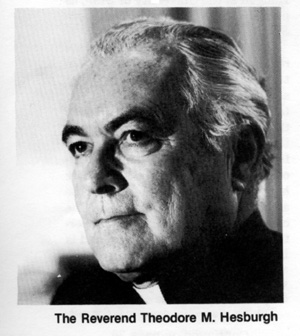 The American Council on Education (ACE) presented The Reverend Theodore M. Hesburgh its second annual award in recognition of his outstanding lifetime contribution to higher education. The award presentation was made during ACE's annual meeting in Washingon, D.C. during October 1981. The award presented to Hesburgh consists of a 9 centimeter diameter crystal sphere called "Galaxy". Designed by artist Donald Pollard for Steuben Glass, "Galaxy" was created to commemorate momentous achievements in the U.S. space program including the manned Space Shuttle and the Voyager encounters with Jupiter and Saturn.
The American Council on Education (ACE) presented The Reverend Theodore M. Hesburgh its second annual award in recognition of his outstanding lifetime contribution to higher education. The award presentation was made during ACE's annual meeting in Washingon, D.C. during October 1981. The award presented to Hesburgh consists of a 9 centimeter diameter crystal sphere called "Galaxy". Designed by artist Donald Pollard for Steuben Glass, "Galaxy" was created to commemorate momentous achievements in the U.S. space program including the manned Space Shuttle and the Voyager encounters with Jupiter and Saturn.
Hesburgh, 64, is an educator, author and distinguished public servant. In 1964 he was awarded the Presidential Medal of Freedom, our nation's highest civilian honor. Author of books including "A Challenge for the year 2000" and "The Hesburgh Papers: Higher Values in Higher Education". Hesburgh has been President of Notre Dame for 30 years. Retiring as
president later this year, it is reported that he will then become Chancellor of the University.
A member of the Editorial Board of COSMIC SEARCH, Father Hesburgh has served on a number of national science and space committees and wrote the Foreword to the recent NASA Report on "SETI: The Search for Extraterrestial Intelligence" edited by Philip Morrison of M.I.T. and John Billingham and John Wolfe of NASA/Ames Research Center. (NASA Report SP-419).
As reported in the Spring 1981 issue of COSMIC SEARCH, Dr. Hesburgh has been honored by the naming of an asteroid orbiting between Mars and Jupiter as "Asteroid Hesburgh-1952".
Just before going to press, it was learned that, out of a field of 400 candidates, the Notre Dame Search Committee found no qualified successors to Dr. Hesburgh and recommended that he continue another five years as President. Father Hesburgh has agreed, albeit reluctantly.
•
Proxmire vs. SETI
As noted in Frank Drake's column and in SEnTInel, Senator William Proxmire of Wisconsin recently made headlines about SETI. Three years ago he grabbed headlines by awarding NASA's proposed SETI project his "Golden Fleece" award, arguing that the project was a waste of money because any intelligent life out there might be extinct by the time a message was received.
But like the Golden Fleece which the legendary Jason sought, a message from an extinct civilization might be the very one we need most. Learning why the civilization became extinct could help us from becoming extinct also. The ancient Greek, Roman and Egyptian civilizations are long gone but we have been greatly enriched by their documents and artifacts which have survived.
In response to Proxmire's most recent criticism of SETI, Charles Redmond of the NASA Office of Space Science said,
"It means we will have to stop looking at our space shore for a message-in-a-bottle cast out by another civilization. Sadly, if you don't look, you will never find anything."
Proxmire called SETI a futile project because "there is not a scintilla of evidence that intelligent life exists beyond our solar system".
To this Redmond replied, "As late as 1491 there was not a scintilla of evidence that America existed."
•
Dyson on SETI
Freeman Dyson, Princeton University astrophysicist, recently commented:
"One shouldn't distinquish between searching for extraterrestrial intelligence and general exploration of the universe. The two are really the same thing.
"If you want to search in an intelligent fashion for intelligent objects, the thing to do is to look in all possible ways at everything, which is the same as doing astronomy."
Dyson's comments are part of an interview published in "The Planetary Report" for August-
September 1981.
•
Clarke's Odyssey Two
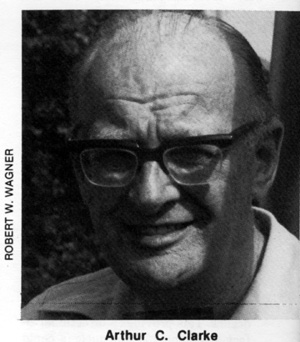 Arthur C. Clarke, noted author and father of the communication satellite, is at work on a sequel to his famous "2001: A Space Odyssey". Some of the spectacular results of the Voyager-Saturn encounters may be woven into the new book, "2010: Odyssey Two", which he hopes to complete this year.
Arthur C. Clarke, noted author and father of the communication satellite, is at work on a sequel to his famous "2001: A Space Odyssey". Some of the spectacular results of the Voyager-Saturn encounters may be woven into the new book, "2010: Odyssey Two", which he hopes to complete this year.
Clarke, who is a member of the Editorial Board of COSMIC SEARCH, has written over 50 books which have sold 20 million copies in 30 languages. His article "Trouble in Aquila" appeared in the premier issue of COSMIC SEARCH (January 1979). His role in proposing the communication satellite is related in "ABCs of Space" in the Summer 1980 issue of COSMIC SEARCH and also in my book "Our Cosmic Universe" (Cygnus-Quasar Books, 1980) pages 11, 12, and 13.
•
Will the BIG ANNOUNCEMENT Come from Moscow?
The item about a December 1981 Soviet SETI conference in the "People and Places" column of the Fall 1981 issue of COSMIC SEARCH resulted in some inquiries by the media. They wanted to know whether COSMIC SEARCH thought that the Russians might be planning to make a Big Announcement concerning their discovery of an extraterrestrial intelligent signal. We replied that we did not know but that strangely enough no American scientists might be in attendance to find out because Senator Proxmire's action, effective Oct. 1, 1981, cut off NASA's travel funds for SETI purposes.
However, pioneer SETI scientist Frank Drake of Cornell University did go and his report on the conference appears elsewhere in this issue.
There is obviously a lot of SETI interest and activity in the Soviet Union. Proxmire's action in cutting off NASA's SETI funding for 1982 will set the U.S. back in its endeavors and will increase the likelihood that if and when a Big Announcement is made it will come from Moscow rather than Washington.
•
Skinner Sees No Hope
B. F. Skinner, renowned Harvard University psychologist sees little hope for mankind to solve its problems of overpopulation, pollution, energy and resource depletion. People do not initiate action but proceed in ways that have worked in the past, he said. Our present dilemma is so different from anything that has occurred before, however, that Dr. Skinner feels the use of old strategies will be ineffective.
If people would act on predictions of future conditions there might be some hope, he said, but it's just not possible to get 5 billion people to change. The few who see the need to change tend not to be powerful. Those in power are concerned only with the present and, he concluded, that if he were powerful he probably would not be interested in the future either.
Burrhus Frederic Skinner is Edgar Pierce Professor Emeritus of Psychology at Harvard University. He is author of more than a dozen books including "The Analysis of Behavior" (1961), "Beyond Freedom and Dignity" (1971) and "About Behaviorism" (1974). His comments were included in a recent interview in "Science Times" of the New York Times.
•
Giacconi to Head Space Telescope Institute
Riccardo Giacconi of the Harvard-Smithsonian Center for Astrophysics has been named as the first director of the Space Telescope Institute at Johns Hopkins University. The institute will manage the NASA 2.4 meter Space Telescope scheduled to be put into low orbit by the Space Shuttle in 1985.
The 49-year-old Giacconi was a principal force behind the first x-ray satellite UHURU launched in 1970 and he is also acting director of the Einstein Observatory, a much more advanced x-ray satellite launched in November 1978.
•
11th Texas Symposium Back in Texas
The "Texas Symposium on Relativistic Astrophysics" has become a mecca for the world's astrophysicists concerned with quasars, pulsars, black holes and the many new and baffling aspects of our universe. Called the "Texas Symposium" because the first ones were at the University of Texas, the Symposium has been held in a number of different places in recent years. But this year (1982) it will again be back in Texas, being held at the Hyatt Regency Hotel in Austin December 13 through 17. Symposium organizer David Evans told COSMIC SEARCH that, as of late October 1981, more than 100 acceptances had been received to invitations he had sent out. No particular topics have yet been singled out for more extensive discussions but it is expected that black holes, heavy neutrinos, x-ray bursters and other timely topics may get a good share of attention.
There was no Texas Symposium in 1981, the last previous one (no. 10) being held in Baltimore in 1980 with the one before that in Munich. The 12th Texas Symposium is scheduled for 1984 in Tel Aviv.
Those interested in more details about the 1982 Texas Symposium should contact David S. Evans, Dept. of Astronomy, University of Texas, Austin, Texas 78712. (Tel. 512-471-4471).
•
Are We Alone?
Since starships of alien civilizations have not already reached the earth, Frank Tipler of Tulane University argues that intelligent extraterrestrial beings do not exist. In recent issues of the "Royal Astronomical Society Quarterly Journal" Tipler also invokes a variety of evolutionary and technological arguments to support his contention.
Tipler's position is interesting as it reflects an extreme opinion. The opposing extreme opinion is that the universe abounds with intelligent life. Those supporting this view argue that absence of evidence is not evidence of absence.
A more open-minded middle position is that we really don't know the answer and to find out we should conduct experimental searches. As Dr. Philip Morrison, pioneer SETI scientist and Institute Professor of Physics at M.I.T. puts it,
"Whether we are alone in the universe or not needs to rest on experimental search, not on a string of evolutionary inferences." (COSMIC SEARCH, Jan. 1979, Serial no. 1, page 7).
•
Saturn Meeting
According to Tom Gehrels of the Lunar and Planetary Laboratory of the University of Arizona, the Saturn meeting scheduled for May 11 to 15, 1982, is doing well with over 100 papers submitted so far. A book with the papers presented is planned for publication early in 1983.
•
By Sail to Centauri
Greogory Matloff and Eugene Mallove have recently described how very thin, space-manufactured sails could be used to launch missions beyond the solar system.
With sails 100 kilometers in diameter, "Clipper Ships of the Galaxy" could reach some of the nearer stars in a few hundred years pulling robot probes or habitats with human crews. Propulsion is by the radiation pressure of sunlight.
Writing in the September 1981 issue of the Journal of the British Interplanetary Society, Matloff and Mallove point out that interstellar missions using solar sails for acceleration and electric or magnetic "drag brakes" for deceleration offer a relatively inexpensive but time-consuming alternative to the nuclear propulsion schemes usually considered by interstellar spacecraft designers.
Dr. Matloff is on the faculty of Pratt Institute and Dr. Mallove is with Astronomy New England.
•
IAU-SETI
Michael D. Papagiannis of Boston University reports that the Executive Committee of the International Astronomical Union (IAU) is proposing a new commission of the IAU called "Search for Extraterrestial Life" for approval at the next General Assembly, August 1982, in Patras, Greece. The IAU is an international organization of professional astronomers representing nearly 50 countries which fosters programs designed to coordinate the efforts of the world's astronomers. The IAU currently has 40 some active commissions, each concerned with a particular branch of astronomy. For example, there are commissions on double stars, variable stars, stellar atmospheres, solar activity, galaxies, radio astronomy, cosmology, etc. The IAU holds a General Assembly once every three years.
In IAU Information Bulletin No. 45 of January 1981, members interested in the proposed new commission are requested to write Professor Michael D. Papagiannis, Dept. of Astronomy, Boston University, 725 Commonwealth Ave., Boston, Mass. 02215.
The IAU sponsored a session on "Strategies for the Search for Life in the Universe" during its General Assembly in Montreal in August 1979. The session was organized by three Commissions of the IAU: Physics of Planets, Radio Astronomy and Space Astronomy. Professor Papagiannis was Chairman of the organizing committee and he reported on the session in the Winter 1980 issue of COSMIC SEARCH (page 24).
•
Super-Narrow Bandwidths for SETI
A few years ago, Frank Drake and George Helou of Cornell University concluded that there was a minimum practical bandwidth for interstellar radio communication. This is set by instabilities of the gas and dust of the interstellar medium causing what is called "incoherence" of the radio waves. The effect might also be described as producing a smearing or fuzziness of the signal. Theoretically, bandwidths approaching zero hertz would be possible if the space between the stars and galaxies was a perfect vacuum permitting communication over almost any distance although at a very slow dash-dot rate of signalling.
Since space is not a perfect vacuum, even a little gas and dust can have an appreciable effect over long paths but Drake and Helou believed that super-narrow bandwidths of as little as one-hundredth hertz (10 millihertz) would be practical. In subsequent tests with the Arecibo telescope, Paul Horowitz of Harvard University demonstrated that such super-narrow bandwidths could be used successfully.
Recently, the Planetary Society made a grant of $10,000 to Horowitz, Ivan Linscott of Dudley Observatory and Allen Peterson of Stanford to assist a $22,000 development effort of a receiver that can listen simultaneously on more than 65,000 channels of 1/64 hertz (16 millihertz) bandwidth covering a total band of one kilohertz. Both Horowitz and Linscott are currently visiting scientists at the NASA-Ames Research Center.
Allen Peterson of Stanford has been involved for some time in a NASA-Ames project for the design and construction of a receiver with 8 million channels of one hertz bandwidth. Such a receiver, called a Multi-Channel Spectral Analyzer, would be an unprecidented achievement and of tremendous value for many types of astronomical research including SETI. But because it is being constructed as a SETI project, work has stopped as a result of the action instigated by Senator Proxmire cutting off all government support for SETI for Fiscal Year 82. This is an unfortunate setback and requires putting the incomplete 8 million channel receiver in mothballs.
Ivan Linscott told COSMIC SEARCH that the grant by the Planetary Society will help keep work going on the super-narrow bandwidth receiver until funding from private sources may be forthcoming for the balance of $12,000 needed to complete the receiver.
In practice the 8-million (1-hertz) channel receiver would comb 8-million hertz segments of the spectrum for unusual signals while the 65,000 (1/64 hertz) channel receiver would do more limited searches of 1 kilohertz bands at specific frequencies corresponding to the hydrogen, deuterium and other lines.
•
ASP Meeting Set
The 93rd annual meeting of the Astronomical Society of the Pacific (ASP) has been set for June 26-July 2, 1982, at the University of California, San Diego (La Jolla, California).
A symposium on Active Extra-galactic Objects, a workshop for schoolteachers, a lecture series on new astronomical developments, observatory tours and an awards banquet are planned. For more details contact: Andrew Fraknoi, A.S.P., 1290 24th Ave., San Francisco, CA 94122.
•
Alignment Bonanza
Occasionally the planets of the solar system achieve an approximate alignment, but they are so far away the physical effects are insignificant. There are those, however, who claim that the impending next alignment will bring fire, flood, famine and pestilence, all of which will occur to at least some extent anyway.
In a recent interview, Ohio State Professor Robert Wing was quoted as saying that the real danger posed by the alignment is the opportunity it provides for con artists to make a fast buck by deceiving a gullible public. If the con artists make enough claims, and anything at all happens, then they can say they were right.
Note: The magnitude of the tidal forces of this alignment, or so-called "Jupiter effect", is readily calculated from Newton's Law of Universal Gravitation. It turns out that the increase in the tidal forces on the Earth due to a perfect alignment of the planets (the one this year is far from perfect) is only of the order of one-thousandth of one percent of the tidal effect produced by the Sun and Moon. In fact, a jet transport flying over a mountain can produce a much larger differential (disruptive) gravitational effect on it than any or all of the planets.

|
|
Letters:
By: Editors
Letters are always welcome but owing to the volume it is not possible to acknowledge all of them. Also due to space limitations we reserve the right where necessary to condense or edit the contents. Letters may be addressed to: Editorial Dept., COSMIC SEARCH, P.O. Box 293, Delaware, Ohio 43015.
COSMIC SEARCH:
Enclosed, please find a copy of a letter I recently received from Senator William Proxmire on the subject of his efforts to squelch the NASA SETI program. The thrust of his argument is the unlikeliness of detection, decoding ability and usefulness. The portion of the Congressional Record he enclosed, indicates that he cited heavily from Professor Tipler's papers to support his contention that the 'best' scientists believe ETI does not exist.
Barry A. Perlman
Fox Observatory
Dania, Florida
Nov. 2, 1981
Mr. Barry A. Perlman
P.O. Box 31
Dania, Florida 33004
Dear Mr. Perlman:
It was good of you to let me know of your opposition to my amendment which deleted funding for the National Aeronautics and Space Administration's search for extraterrestrial intelligence.
I am enclosing a copy of a statement I made on the floor of the Senate outlining why I believe this is not the time to spend Federal tax dollars on such an effort.
Although I was interested to learn that the Soviet Union is pursuing its own search for extraterrestrial intelligence, the mere fact of Soviet involvement does not mean that we would be foolish not to continue our own program. The Soviet Union does not always make wise expenditures any more than the United States does, and I think that as unlikely as it is that we will receive radio signals from an extraterrestrial source it is more unlikely by far that such signals will contain technological information of significant value to the Soviet Union or the United States, even assuming that we could decipher the signals into meaningful language.
In any event, let me assure you that I'll keep your views in mind as debate on the issue continues.
Sincerely,
(Signed) Bill Proxmire
William Proxmire, U.S.S.
U.S. Senate
Committee on Appropriations
Congressional Record
Senate
July 30, 1981
Mr. PROXMIRE. Mr. President, I send an amendment to the desk and ask for its immediate consideration.
The PRESIDING OFFICER. The amendment will be stated.
The legislative clerk read as follows:
The Senator from Wisconsin (Mr. Proxmire) proposes an unprinted amendment numbered 338:
On page 29, line 9, immediately before the period, insert the following:
Provided: That none of these funds shall be used to support the definition and development of techniques to analyze extraterrestrial radio signals for patterns that may be generated by intelligent sources.
Mr. PROXMIRE. Mr. President, 3 years ago, NASA requested $2 million for a program titled "Search for Extraterrestrial Intelligence" — SETI for short.
The idea was that they are going to try to find intelligence outside the solar system. Our best scientists say that that intelligent life would have to be beyond our galaxy. I have always thought if they were going to look for intelligence, they ought to start right here in Washington. It is hard enough to find intelligent life right here. It may even be harder, I might say, than finding it outside our solar system. At any rate, this $2 million would have funded the initiation of an all-sky, all-frequency search for radio signals from intelligent extraterrestrial life using existing antennas of Deep Space Network at Goldstone, Calif., and some state-of-the-art hardware that was to be developed specificaly for the program. The total cost of the program was to be $15 million over 7 years.
These funds were stricken from the fiscal year 1979 HUD-independent agencies appropriation bill a few months after I gave NASA a "Golden Fleece" for the proposed project, which I thought should be postponed for a few million light-years. [Note the incorrect use of the term "light-years"; the correct term should have been "years".]
I have since discovered that the project has been continued at a subsistence level despite our decision to delete these funds 3 years ago. In 1980 NASA spent $500,000 on the project. The 1981 budget was $1 million. NASA plans to spend an aditional [sic; "aditional" should be "additional"] $1 million in 1982 to continue the definition and development of techniques to analyze extraterrestrial radio signals for patterns that may be generated by intelligent sources.
Mr. President, clearly the Congress intended to stop this research back in 1978 when it terminated funding for the program. However, NASA has quietly continued the work under its exobiology program. I believe the rationale for the reduction we made 3 years ago still applies, and the amendment I have just sent to the desk would reaffirm that decision by prohibiting NASA from using funding provided in today's bill to pursue the search for extraterrestrial intelligence.
Why should we stop this program, Mr. President?
First, if NASA launches a full scale SETI program the total cost will be at least $50.9 million over 10 years. This is a luxury we can ill afford at a time when we are making a herculean effort to cut Federal spending.
Second, there is an excellent chance that extraterrestrial intelligent beings do not exist. An article appearing in the April 1981 issue of Physics Today, written by a professor of mathematical physics at Tulane University, Frank J. Tipler, spelled out this thesis in great detail. Professor Tipler's central point is that if intelligent beings did exist elsewhere and possessed the technology for interstellar communication they would have developed interstellar travel and thus would already be present in our solar system. Certainly, there is not a scintilla of evidence that intelligent life exists beyond our solar system.
Third, even if a radio message had been beamed to our planet from some distant civilization, it could well have originated well over a million years ago. The Earth itself is 4 1/2 billion years old while some solar systems are even older and millions of light-years from Earth. Thus the intelligent life that sent the message might well be extinct by the time we received it or, certainly, by the time we responded. Communication over such great distances is almost meaningless.
Finally, Mr. President, if we continue to allow NASA to pursue this effort to intercept signals from some hypothetical intelligent civilization, we are sending exactly the wrong signal to the American taxpayer.
We should worry more about improving our ability to communicate with our neighbors on planet Earth and worry a little less about interstellar conversation. In this year of all years we should not fritter away precious Federal dollars on a project that is almost guaranteed to fail. I hope my colleagues will support my amendment to stop this ridiculous waste of the taxpayer's dollars.
The PRESIDING OFFICER. Who yields time?
Mr. GARN. Mr. President, on this amendment, the Senator from Wisconsin and I do not disagree. I realize he has a great deal more experience, having been in the Senate a lot longer than I and trying to find intelligence in Washington. I suppose that, at the very least, if we were going to spend the money, it would make more sense to transfer it for that search, but that probably would be just as wasteful as the Senator has pointed out. I am willing to accept the amendment.
Mr. HUDDLESTON. Mr. President, on this side, we, too, are willing to accept the amendment of the Senator from Wisconsin and commend him for his diligence in ferreting out unnecessary expenditures and seeking to reduce them.
Nov. 5, 1981
Senator William Proxmire
5241 Dirksen Bldg.
Washington, D.C. 20510
Dear Senator Promire:
Thank you for your letter of November 2nd in which you express your views of my earlier correspondence. I have read your letter and attached statement you made on the Senate floor several times and because of its familiarity dug up some historical information I had kept for some years.
I discovered that in the mid 1800s, one of your colleagues made an almost identical speech on the floor of the Congress in which he labeled as a waste of the taxpayer's money the proposal of Mr. Morse to construct a telegraph line between the city of Washington D.C. and Baltimore, Md. In his presentation, he outlined the lack of feasibility, practicality and usefulness of such a project. In retrospect, of course, we now know he was right. After all, who would want to communicate with Baltimore, anyway?
Sincerely,
Barry A. Perlman
Dania, Florida
The "Proxmire Effect"
Please note that Senator Proxmire cites Tipler in support of his contentions. Tipler, in turn, bases his argument on one whopper of an assumption, namely, that a technological civilization would build highly-intelligent self-replicating Bracewell probes which would over run the galaxy in a few million years. (See "People and Places", page 33; also COSMIC SEARCH, no. 2, page 48). Since we have no evidence of such probes in the solar system, Tipler concludes that we must, therefore, be alone in our galaxy. One of a number of flaws in Tipler's argument is that if the technological civilization had a Senator Proxmire, its probes would never have been launched. Thus, the "Proxmire effect" could stagnate a civilization and nullify the "Bracewell effect". In other words, if other civilizations are afflicted with the "Proxmire effect", Senator Proxmire's arguments are invalid and THEY really might be out there without our knowing it until such time as we chance upon some of their incidental radio signals.
— Ed.
|
|
Miscellaneous Items
Webpage Table of Contents (Bookmarks)
(Internal links to categories of items in this webpage)
Information About the Publication
(Editorial Board, Editors, Table of Contents)

COSMIC SEARCH - an international, interplanetary, interstellar, intergalactic magazine
Editors, and Others Involved in the Publication
Editor: John Kraus, Director, Ohio State University Radio Observatory
Contributing Editors:
H. James Birx, Canisius College
Leonard David, National Space Institute
Robert S. Dixon, Ohio State University
Frank D. Drake, Cornell University
David Swift, University of Hawaii
Robert H. VanHorn, Bell Telephone Laboratories (retired)
Assistants: Alice Kraus, Pene Curmode
Staff Artist: Jim Arthur
Editorial Board
- Richard Berendzen, President, The American University
- John Billingham, Director SETI Program, NASA-AMES Research Center
- Ronald Bracewell, Director, Radio Astronomy Observatory, Stanford University
- Arthur C. Clarke, Sri Lanka, author of "2001, A Space Odyssey"
- Norman Cousins, Chairman, Editorial Board, SATURDAY REVIEW
- Frank D. Drake, Director, National Astronomy and Ionosphere Center (Arecibo), Cornell University
- Donald S. Hall, Director, Strasenburgh Planetarium, Rochester, New York; Past President, International Planetarium Society
- Theodore M. Hesburgh, President, University of Notre Dame
- Nikolai Kardashev, Space Research Institute, Academy of Sciences, Moscow, USSR
- Philip Morrison, Physics Department, Massachusetts Institute of Technology
- Bernard Oliver, Vice President, Hewlett-Packard Company; Director of NASA-Ames Cyclops Project
- Cyril Ponnamperuma, Director, Laboratory of Chemical Evolution, University of Maryland
- Martin Rees, Director, Institute of Astronomy, Cambridge University, England
- Carl Sagan, Director, Laboratory for Planetary Studies, Cornell University
- Walter Sullivan, Science Editor, New York Times
- Vasevolod R. Troitsky, Radiophysical Scientific Research Institute, Gorky, USSR
- Sebastian von Hoerner, National Radio Astronomy Observatory
About COSMIC SEARCH
The name COSMIC SEARCH is a registered trademark.
COSMIC SEARCH is published twice yearly (Jan.-June; July-Dec.) by Cosmic-Quest, Inc. Copyright © 1982 by Cosmic-Quest, Inc. All rights reserved. Cosmic Quest, Inc., is a non-profit educational-scientific organization.
Opinions expressed by persons writing in COSMIC SEARCH are their own and do not necessarily reflect the opinions of the editorial staff.
Subscription price: $12 for 4 issues (2 years) in U.S. (and possessions), $16 elsewhere. Single copies: $3.00 in U.S. (and possessions), $3.50 elsewhere.
Address subscriptions and all other correspondence to: Radio Observatory, Box 293, Delaware, Ohio 43015.
Second-class postage is paid at Delaware, Ohio, and at additional mailing offices.
Note to subscribers: The last digits of the top line of your address label indicate the serial number of the last issue of your subscription. This issue is serial number 13.
Editor's Statement
With this issue COSMIC SEARCH goes to two issues a year. My responsibilities for editing, publishing, and distributing four issues a year almost single-handedly are more than I can manage along with my many other activities. With this change the price goes from $2.50 to $3.00 per copy. New subscriptions will be on the basis of a minimum of 4 issues (2 years) for $12.00 ($16.00 outside the U.S.). The costs of entering, billing and maintaining accounts make a 2-issue (1 year) subscription impractical. Subscriptions already in effect will be honored for the number of issues for which payment has been made. Thus, a 2-year (8 issue) subscription on the old basis converts to a 4-year (8 issue) subscription on the new basis.
John Kraus
Front Cover
Grote Reber and the First Radio Maps of the Sky. Story on page 14.
Table of Contents (in magazine)
| CONTENTS | Pg |
|---|
| "SETI Symposium Report" by Frank D. Drake | 4 |
| "The Last Question" by Michael A. G. Michaud | 6 |
| "Putting the Cosmos on Hold" by Frank D. Drake | 8 |
| "U.S. Space Policy: The Continuing Controversy" by Marcia S. Smith | 10 |
| "Extrasolar Planetary Foundation Report" by George D. Gatewood | 9 |
| "The First 50 Years of Radio Astronomy; Part 2; Grote Reber and the First Radio Maps of the Sky" by John Kraus | 14 |
| "Impressions of Voyager 2 and Saturn" by David W. Swift | 20 |
| "When to Look Where" by Clifford E. Singer | 22 |
| "The Cosmic Quest" by James Birx and Gary R. Clark | 29 |
| Features: | |
| Donors | 2 |
| Editor's Statement | 3 |
| Faraday-Maxwell-Jansky 1831-1931 | 19 |
| ABCs of Space: "The Satellite Revolution" | 24 |
| SEnTInel: Proxmire, Star Seasons, Neutrinos, Gravity
Lenses | 30 |
| People and Places | 32 |
| Letters | 35 |
| Financial Statement | 36 |
| Circulation Statement | 36 |
| COSMIC SEARCH "First 3 Years" bound volume | 36 |
| Order Blanks | 37 |
Thank you Friends of the Cosmic Quest
COSMIC SEARCH expresses sincere thanks to the following donors who are helping to make sure that the story of SETI and mankind's future continue to be told in an interesting and factual way.
Planetary Donors
Robert J. Allen, Blythdale, Missouri
George Austin, M.D., Loma Linda, California
Donald R. Blaney, Seattle, Washington
Jane L. Brooks, Adelaide, S. Australia
Walter W. Buchanan, Lebanon, Indiana
Vera Buescher, Mountain View, California
Jack Craig, Oregon City, Oregon
Felix Dinkelmann, M.D., Obfelden, Switzerland
William E. Dorion, McLean, Virginia
Amahl S. Drake, Ithaca, New York
Harry Duke, Los Altos, California
Harold Early, Ann Arbor, Michigan
Nancy F. Eberbach, Ann Arbor, Michigan
Hale P. Faris, San Jose, California
B. Fredricksen, White Bear Lake, Minnesota
Richard and Maria Gauthier, North Bay, Ontario
Paul J. Hurm, Seven Mile, Ohio
Miroslav Jergovic, Umag, Yugoslavia
James C. Killman, Sherman, Texas
David M. Laida, Sierra Vista, Arizona
Nelson Lecklikner, Novata, California
John L. Mohn, San Antonio, Texas
Arthur J. Morgan, New York, New York
Wayne Reagor, Pompano Beach, Florida
William Rhodes, Phoenix, Arizona
A. V. Shaver, Winchester, Virginia
Paul Simmons, Sheboygan, Wis.
Eric W. Six, Iowa City, Iowa
Rohert S. Strause, Stroudsburg, Pennsylvania
John B. Theiss, Tucson, Arizona
Inge Bjart Torkildsen, Montiquar, France
Dennis Wildfogel, Pomona, N.J.
Two Anonymous
Stellar Donors
Jane L. Brooks, Adelaide, S. Australia
Keith Conrad, Toledo, Ohio
George L. Douglass, II, Reno, Nevada
Harold Early, Ann Arbor, Michigan
Extrasolar Planetary Foundation, Pittsburgh, Pennsylvania
John Fadum, Boca Raton, Florida
David C. Halley, Colonial Hts., Virginia
Christopher E. Mullin, Sr., Tiburon, California
Virginia Shaver, Winchester, Virginia
Paul Simmons, Sheboygan, Wisconsin
John Teetor, Marion, Ohio
C.L. Turnage, Camarillo, California
Cosmic Donors
Two anonymous
COSMIC SEARCH, published by a non-profit scientific-educational organization, has been granted tax-exempt status by the Internal Revenue Service, so contributions are tax-deductible (but subscriptions are not). On a combination donation-subscription or donation-renewal, the amount over and above the magazine cost is tax deductible. For example, if a donor sends $30 (qualifying as a "Planetary Donor") and includes a two-year subscription at $12, the $18 difference is tax-deductible.
Donation categories are as follows:
Planetary: $30 per year
Stellar: $100 per year
Galactic: $500 per year
Cosmic: $1000 per year
Contributions, however, will be gratefully accepted in any amount. Checks should be made payable to Cosmic Quest, Inc., P.O. Box 293, Delaware, Ohio 43015.
Financial Statement for COSMIC SEARCH
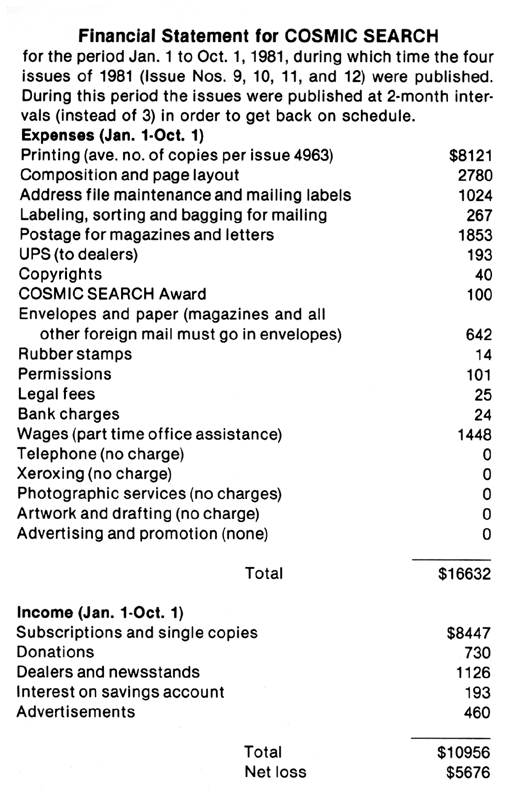
Statement of Ownership, Management and Circulation

Miscellaneous Quotes
The following quotes are not directly associated with any article.
The following miscellaneous item was located on the inside front cover.
DELTA VEE
In one year Delta Vee has become one of the most effective and visible space groups. Through its Viking Fund to help keep pictures and weather data coming from Mars, its Halley Fund to send a probe to Halley's Comet, its Ferdinand and Isabella Fund for supporting space exploration concepts and its Extraterrestrial Connection Fund for supporting NASA SETI programs, Delta Vee is actively working for an expanded, dynamic space program.
Delta Vee, Inc., is a citizen's supported, non-profit space corporation. The name "Delta Vee" comes from the technical term meaning a change in velocity. Delta Vee wants more "Delta Vee" to increase the speed with which we explore space. Delta Vee is a space corporation of the people, for the people, by the people, representing over 20,000 persons who have contributed funds to help support NASA programs.
Contributions for Delta Vee's various projects may be sent to Delta Vee Inc., 3033 Moorpark Ave., Suite 27, San Jose, CA 95128.
•
The following quote was located on page 37.
True wit is nature to advantage dressed,
What oft was thought, but ne'er so well expressed.
Alexander Pope (1688-1744)
|
![[NAAPO Logo]](../../Images/NAAPOsm.jpg)

